Ontario’s Early Years and Child Care Annual Report 2021
Ontario’s Early Years and Child Care Annual Report 2021 describes the early years and child care system, key data and measures for child care and indicators under the Canada-Ontario Early Learning and Child Care Agreement.
Introduction
We know the integral role that the early years and child care system plays in supporting families and giving every child the best possible start in life. That is why the provincial government remains committed to building a system that is high quality, inclusive and affordable.
To enable a better understanding of Ontario’s early years and child care system, this report provides an annual snapshot and year-over-year trends in the sector. In addition, the report supports Ontario's commitment under the Canada-Ontario Early Learning and Child Care Agreement to publish its progress.
Most of the data presented in this report was collected between March 2020 and March 2021. In early 2020, COVID‑19 arrived in Canada, affecting the lives of all Ontario residents. The pandemic has created significant health and economic hardship for families. It has also had major economic and operational impacts on the child care sector.
Ontario’s early years and child care system continues to weather the COVID‑19 pandemic. As of March 31, 2021:
- The number of licensed child care spaces grew by 1,736 to 464,538 spaces. Almost all age groups have seen an increase in spaces: a three per cent increase for infants, a two per cent increase for toddlers, a less than 0.4% increase for preschool and kindergarten, and an increase from 692 to 842 spaces for the “family age group”.
footnote 1 The only exception is the school age spaces which slightly decreased by about 0.3%. - The number of licensed child care centres decreased by one per cent from 5,565 to 5,506 centres.
- Of the total number of licensed child care centres, 2,986 centres were located in publicly funded schools, 17 centres fewer compared to last year.
- The number of home child care agencies increased by 6.1% from 131 to 139. There were 8,561 approved homes affiliated with these agencies, representing a 3.2% increase.
- More than 2,000 individuals were approved to receive grants to support them in obtaining an early childhood education diploma or leadership credentials.
Ontario provided a range of supports to assist the child care sector and Ontario families during the COVID‑19 pandemic. Key activities included:
- funding of $234.6 million by the Ontario government, in partnership with the federal government, to keep children and staff safe in child care and early years settings
- funding of $66 million to Consolidated Municipal Service Managers and District Social Services Administration Boards (CMSMs and DSSABs) for reinvestment between the period of January and March 2021 to support increased costs of operating child care and EarlyON Child and Family Centres during the COVID‑19 pandemic
- establishing emergency child care paid for by the province and at no cost to parents to support frontline workers, over three different time periods between March 2020 and June 2021
- supporting child care centres to reopen once strict health and safety measures had been met, based on guidance documents developed in partnership with provincial health and labour ministries as well as federal, municipal and child care sector partners
- providing more than 6,000 licensed child care programs, EarlyON Child and Family Centres and First Nation child and family programs with personal protective equipment (PPE) such as masks, face shields and rapid test kits to support the healthy and safe operations of programs
- ensuring continuous funding for EarlyON Child and Family Centres to provide virtual services and other supports to families during closure periods
- prohibiting child care providers from charging child care fees to parents over the past year when the province closed child care and therefore care was not being provided
- helping parents pay for the extra costs associated with school and child care closures during the COVID‑19 outbreak with the Support for Families program, by providing a one-time payment of $200 per child up to 12 years of age, and $250 for those with special needs up to 21 years of age, from April 2020 to August 2020
- providing the Ontario COVID‑19 Child Benefit in May 2021, where payments to help offset additional learning costs were $400 per child and $500 for a child with special needs
A stable and accessible child care system will be crucial in supporting Ontarians through the ongoing COVID‑19 pandemic and in supporting Ontario’s recovery afterwards. In 2021-22, the provincial government will continue to support families and the early years and child care system by:
- investing more than $2 billion in early years and child care funding, including approximately $390 million annually to support the child care tax credit, with the government providing a 20 per cent one-time top-up for the 2021 tax year
- implementing the new agreement with the federal government on the Canada-wide Early Learning and Child Care system
- implementing the new one-year Canada-Ontario Early Childhood Workforce Funding Agreement to support the recruitment and retention of the early childhood workforce in 2021-22
- continuing to support the early years and child care sector to ensure the health and safety of families and the viability of these critical programs, through the provision of health and safety protocols, PPE, and rapid testing, as we continue to manage through the COVID‑19 outbreak
- supporting families in need of fee subsidies and providing funding to municipalities for this purpose
- creating up to 30,000 child care spaces in schools over five years, including up to 10,000 spaces in new schools
- allocating $203 million to municipalities in 2021 to support wage enhancements for eligible child care professionals
Moreover, Ontario looks forward to the implementation of the National Child Care Plan to ensure parents and children benefit from a high-quality child care system that is affordable, flexible and works for Ontario’s families . We continue to work to ensure the necessary resources and protections are in place to help the child care sector through the COVID‑19 pandemic. We recognize that there is still much to be done and will continue to monitor and adapt as the situation evolves.
Finally, to our partners in the early years and child care sector: child care workers, child care operators, First Nation communities, Consolidated Municipal Service Managers and District Social Services Administration Boards - we would like to say thank you. Thank you for all you have done to keep Ontario’s children well cared for and safe. Your partnership and unwavering commitment to families has been crucial during this unprecedented time.
Ontario’s child care system and COVID response
Since COVID‑19 arrived in Canada in early 2020, it has affected the lives of each and every Ontarian. It has resulted in major health impacts and economic challenges for families and the early years and child care sector. As of March 31, 2021, 5,282 (96%) of the 5,506 licensed child care centres and 129 (93%) of the 139 licensed home child care agencies reopened following the emergency closures resulting from the COVID‑19 pandemic.
The effects of the COVID‑19 pandemic continue to be felt by families, businesses, and communities across Ontario. Throughout the pandemic and to mitigate its impact on families and the early years and child care sector, the Ontario government supported:
- children of frontline workers through emergency child care programs that were designed to help frontline workers continue to deliver critical services while providing a safe environment for their children, at no cost to parents
- mental health and well-being of children and families through the continuation of virtual programs and supports in EarlyON Child and Family Centres
- early years and child care programs by instituting a range of funding approaches to support sustainability, including the direct provision of PPE and funding to support increased costs associated with staffing, cleaning and meeting other health and safety measures
- public health objectives by establishing operational guidance to support child care operators in adhering to evidence-based health and safety protocols
- Ontario families through two support programs (such as Support for Families) which provided one-time direct payments to parents to assist with the costs of supporting their children’s early learning needs during the pandemic
Emergency child care for frontline workers
In partnership with CMSMs and DSSABs, First Nation communities and child care licensees, the Ministry of Education implemented the provincial emergency child care program for children of healthcare and other front-line workers during three different periods throughout the COVID‑19 pandemic.
The program provided high-quality and safe child care, free of charge, to help mitigate the impact of child care and school closures on the families of front-line workers who were required to perform critical services within their community in-person. This was fully funded by the province during all three periods.
The ministry implemented the first iteration of the emergency child care program (ECC) early in the pandemic from mid-March 2020 to the end of June 2020, as child care centres were permitted to reopen under strict health and safety measures following the province-wide emergency closure period.
The ministry implemented the second iteration of emergency child care program for elementary and school-aged children, from January 4, 2021 to February 16, 2021, when all programs across the province were able to resume regular operations with enhanced health and safety precautions following the remote learning period.
The ministry implemented the third emergency child care program for elementary and school-aged children from April 19, 2021 to the end of June 2021. At its peak, during the third wave of the pandemic, the emergency child care program served more than 12,000 children per day and operated for 10 weeks. The emergency child care program came to an end on June 30, 2021 when the school year ended and all child care programs across the province were able to resume regular operations with enhanced health and safety precautions.
Implementation of emergency child care was only possible due to the leadership and hard work of our municipal and First Nation partners and dedicated child care supervisors, early childhood educators and program staff.
Ensuring the health, safety and wellbeing of children, families and staff
Ontario’s top priority is the health and safety of children, families and providers and staff. During the COVID‑19 pandemic, the Ministry of Education, under the advice of the ministries of Health and Labour, Training and Skills Development, Public Health Ontario and the Office of the Chief Medical Officer of Health, has established and updated operational guidance that set out evidence-based public health and safety protocols for child care, EarlyON Child and Family Centres and before and after school programs. Separate guidance was also developed for First Nation communities who operate licensed child care and child and family programs. The guidance includes information related to health and safety requirements such as the use of PPE, cleaning protocols, pre-program considerations such as staff training and in-program considerations such as equipment and toy usage and space set-up.
To support the safe reopening of licensed child care and early years programs, the Ontario government delivered PPE approved by Health Canada, free of charge, to staff working in these settings. These programs, including licensed centres, licensed home child care agencies, emergency child care sites and early years programs, when open, are provided a monthly supply of PPE.
To date, more than 6,000 licensed child care programs, EarlyON Child and Family Centres and First Nation child and family programs across the province have received PPE.
The ministry also released Building on how does learning happen: pedagogical approaches to re-opening early years and child care programs in Ontario to support the operation of early years and child care programs in Ontario during the COVID‑19 pandemic. This document provides information on how early years settings can provide safe and healthy environments and support the social and emotional health and well-being of children and families.
Funding support for early years and child care programs
Since the beginning of the COVID‑19 pandemic, the Ontario government instituted a range of funding approaches to support sustainability and recovery of the early years and child care sector in the province. During the closure and reopening periods, provincial funding was provided to support all child care operators (with fixed overhead costs while closed and other expenses related to reopening such as vacancies, enhanced cleaning and PPE).
The province continued to fund child care providers and EarlyON Child and Family Centres through service system managers, as the sector recovered during this time. In 2020-21, the government invested over $2 billion in early years and child care, including approximately $303 million for the Ontario Child Care Tax Credit.
In addition, the Ontario government, in partnership with the federal government, provided $234.6 million in funding to keep children and staff safe in child care and early years settings. This funding helped to support enhanced cleaning costs as well as health and safety requirements set out to support the reopening of licensed child care and early years programs. This funding was in addition to the Ontario government's continued commitment to stabilize the child care sector.
The ministry also made $66 million available to CMSMs and DSSABs for reinvestment between January and March 2021 to support the increased costs of operating child care and EarlyON Child and Family Centres during the COVID‑19 pandemic.
In summary, the COVID‑19 pandemic has challenged the child care sector and although it has to a large extent weathered the storm, we recognize that the sector is fragile. The ministry is supporting the operations of child care by putting the health and safety of children and families first and ensuring its sustainability. To that end, Ontario will continue to engage with the sector and monitor and support it. Since the start of the COVID‑19 pandemic, child care settings have largely remained open to support Ontario families. Child care operators and educators have worked tirelessly to ensure the safety of children in care, while balancing the need to provide a healthy and caring learning environment.
Part 1: Overview of the early years and child care system
The Ministry of Education sets overall policy, legislation, and regulations for the child care and early years sector, under the authority of the Child Care and Early Years Act, 2014, and licenses child care providers across the province. The ministry also conducts inspections and investigates complaints about licensed and unlicensed child care.
The ministry oversees and licenses two types of child care:
- licensed child care centres
- home child care agencies, that contract with home child care providers
The provincial government provides funding to 47 local service system managers, known as Consolidated Municipal Service Managers (CMSMs) and District Social Services Administration Boards (DSSABs), to support licensed child care and child and family programs in the province (see Figure 1). These service system managers have the authority to determine funding priorities within their local systems, provided they comply with provincial legislation, policies and guidelines.
Figure 1: Consolidated Municipal Service Managers and District Social Services Administration Boards in Ontario
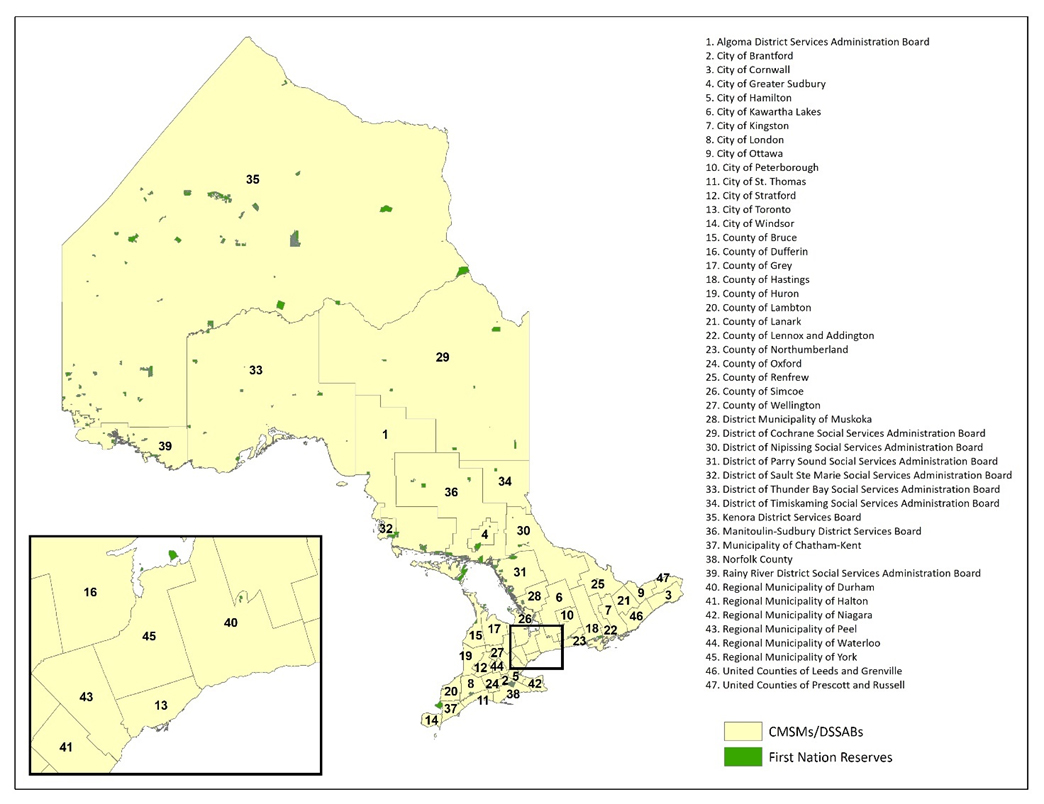
| Location name | Type |
|---|---|
| Algoma District Services Administration Board | Consolidated Municipal Service Managers/District Social Services Administration Boards |
| City of Brantford | Consolidated Municipal Service Managers/District Social Services Administration Boards |
| City of Cornwall | Consolidated Municipal Service Managers/District Social Services Administration Boards |
| City of Greater Sudbury | Consolidated Municipal Service Managers/District Social Services Administration Boards |
| City of Hamilton | Consolidated Municipal Service Managers/District Social Services Administration Boards |
| City of Kawartha Lakes | Consolidated Municipal Service Managers/District Social Services Administration Boards |
| City of Kingston | Consolidated Municipal Service Managers/District Social Services Administration Boards |
| City of London | Consolidated Municipal Service Managers/District Social Services Administration Boards |
| City of Ottawa | Consolidated Municipal Service Managers/District Social Services Administration Boards |
| City of Peterborough | Consolidated Municipal Service Managers/District Social Services Administration Boards |
| City of St. Thomas | Consolidated Municipal Service Managers/District Social Services Administration Boards |
| City of Stratford | Consolidated Municipal Service Managers/District Social Services Administration Boards |
| City of Toronto | Consolidated Municipal Service Managers/District Social Services Administration Boards |
| City of Windsor | Consolidated Municipal Service Managers/District Social Services Administration Boards |
| County of Bruce | Consolidated Municipal Service Managers/District Social Services Administration Boards |
| County of Dufferin | Consolidated Municipal Service Managers/District Social Services Administration Boards |
| County of Grey | Consolidated Municipal Service Managers/District Social Services Administration Boards |
| County of Hastings | Consolidated Municipal Service Managers/District Social Services Administration Boards |
| County of Huron | Consolidated Municipal Service Managers/District Social Services Administration Boards |
| County of Lambton | Consolidated Municipal Service Managers/District Social Services Administration Boards |
| County of Lanark | Consolidated Municipal Service Managers/District Social Services Administration Boards |
| County of Lennox & Addington | Consolidated Municipal Service Managers/District Social Services Administration Boards |
| County of Northumberland | Consolidated Municipal Service Managers/District Social Services Administration Boards |
| County of Oxford | Consolidated Municipal Service Managers/District Social Services Administration Boards |
| County of Renfrew | Consolidated Municipal Service Managers/District Social Services Administration Boards |
| County of Simcoe | Consolidated Municipal Service Managers/District Social Services Administration Boards |
| County of Wellington | Consolidated Municipal Service Managers/District Social Services Administration Boards |
| District Municipality of Muskoka | Consolidated Municipal Service Managers/District Social Services Administration Boards |
| District of Cochrane Social Services Administration Board | Consolidated Municipal Service Managers/District Social Services Administration Boards |
| District of Nipissing Social Services Administration Board | Consolidated Municipal Service Managers/District Social Services Administration Boards |
| District of Parry Sound Social Services Administration Board | Consolidated Municipal Service Managers/District Social Services Administration Boards |
| District of Sault Ste Marie Social Services Administration Board | Consolidated Municipal Service Managers/District Social Services Administration Boards |
| District of Thunder Bay Social Services Administration Board | Consolidated Municipal Service Managers/District Social Services Administration Boards |
| District of Timiskaming Social Services Administrations Board | Consolidated Municipal Service Managers/District Social Services Administration Boards |
| Kenora District Services Board | Consolidated Municipal Service Managers/District Social Services Administration Boards |
| Manitoulin-Sudbury District Services Board | Consolidated Municipal Service Managers/District Social Services Administration Boards |
| Municipality of Chatham-Kent | Consolidated Municipal Service Managers/District Social Services Administration Boards |
| Norfolk County | Consolidated Municipal Service Managers/District Social Services Administration Boards |
| Rainy River District Social Services Administration Board | Consolidated Municipal Service Managers/District Social Services Administration Boards |
| Regional Municipality of Durham | Consolidated Municipal Service Managers/District Social Services Administration Boards |
| Regional Municipality of Halton | Consolidated Municipal Service Managers/District Social Services Administration Boards |
| Regional Municipality of Niagara | Consolidated Municipal Service Managers/District Social Services Administration Boards |
| Regional Municipality of Peel | Consolidated Municipal Service Managers/District Social Services Administration Boards |
| Regional Municipality of Waterloo | Consolidated Municipal Service Managers/District Social Services Administration Boards |
| Regional Municipality of York | Consolidated Municipal Service Managers/District Social Services Administration Boards |
| United Counties of Leeds & Grenville | Consolidated Municipal Service Managers/District Social Services Administration Boards |
| United Counties of Prescott and Russell | Consolidated Municipal Service Managers/District Social Services Administration Boards |
Data sources: Ontario Ministry of Education and Statistics Canada.
As of March 31, 2021, the province was funding 96 First Nations to support child care and/or child and family programs on reserve (see Figure 2), of which:
- 31 received funding for child care only
- 21 received funding for child and family programs only
- 44 received funding for child care and child and family programs
Figure 2: Ontario First Nations receiving provincial funding for child care and/or child and family programs
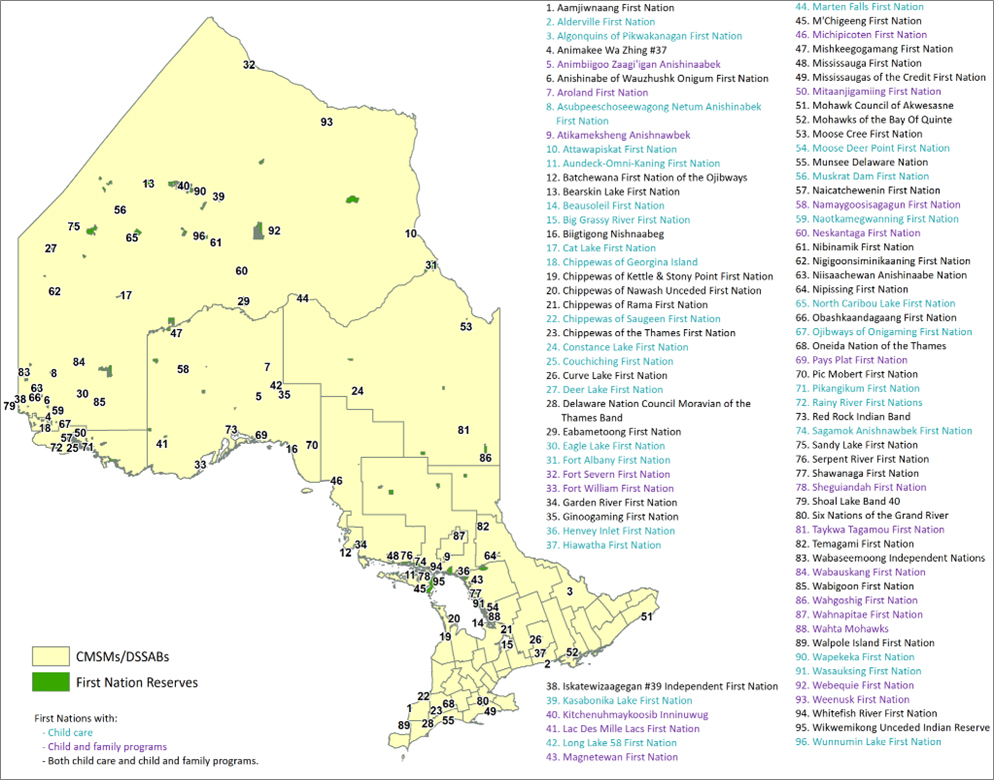
| Location name | Type | Key |
|---|---|---|
| Aamjiwnaang First Nation | First Nation Reserves | Received provincial funding for child care and child and family programs |
| Alderville First Nation | First Nation Reserves | Received provincial funding for child care |
| Algonquins of Pikwakanagan First Nation | First Nation Reserves | Received provincial funding for child care |
| Animakee Wa Zhing #37 | First Nation Reserves | Received provincial funding for child care and child and family programs |
| Animbiigoo Zaagi'igan Anishinaabek | First Nation Reserves | Received provincial funding for child and family programs |
| Anishinabe of Wauzhushk Onigum First Nation | First Nation Reserves | Received provincial funding for child care and child and family programs |
| Aroland First Nation | First Nation Reserves | Received provincial funding for child and family programs |
| Asubpeeschoseewagong Netum Anishinabek First Nation | First Nation Reserves | Received provincial funding for child care |
| Atikameksheng Anishnawbek | First Nation Reserves | Received provincial funding for child and family programs |
| Attawapiskat First Nation | First Nation Reserves | Received provincial funding for child care |
| Aundeck-Omni-Kaning First Nation | First Nation Reserves | Received provincial funding for child care |
| Batchewana First Nation of the Ojibways | First Nation Reserves | Received provincial funding for child care and child and family programs |
| Bearskin Lake First Nation | First Nation Reserves | Received provincial funding for child care and child and family programs |
| Beausoleil First Nation | First Nation Reserves | Received provincial funding for child care |
| Big Grassy River First Nation | First Nation Reserves | Received provincial funding for child care |
| Biigtigong Nishnaabeg | First Nation Reserves | Received provincial funding for child care and child and family programs |
| Cat Lake First Nation | First Nation Reserves | Received provincial funding for child care |
| Chippewas of Georgina Island | First Nation Reserves | Received provincial funding for child care |
| Chippewas of Kettle & Stony Point First Nation | First Nation Reserves | Received provincial funding for child care and child and family programs |
| Chippewas of Nawash Unceded First Nation | First Nation Reserves | Received provincial funding for child care and child and family programs |
| Chippewas of Rama First Nation | First Nation Reserves | Received provincial funding for child care and child and family programs |
| Chippewas of Saugeen First Nation | First Nation Reserves | Received provincial funding for child care |
| Chippewas of the Thames First Nation | First Nation Reserves | Received provincial funding for child care and child and family programs |
| Constance Lake First Nation | First Nation Reserves | Received provincial funding for child care |
| Couchiching First Nation | First Nation Reserves | Received provincial funding for child care |
| Curve Lake First Nation | First Nation Reserves | Received provincial funding for child care and child and family programs |
| Deer Lake First Nation | First Nation Reserves | Received provincial funding for child care |
| Delaware Nation Council Moravian of the Thames Band | First Nation Reserves | Received provincial funding for child care and child and family programs |
| Eabametoong First Nation | First Nation Reserves | Received provincial funding for child care and child and family programs |
| Eagle Lake First Nation | First Nation Reserves | Received provincial funding for child care |
| Fort Albany First Nation | First Nation Reserves | Received provincial funding for child care |
| Fort Severn First Nation | First Nation Reserves | Received provincial funding for child and family programs |
| Fort William First Nation | First Nation Reserves | Received provincial funding for child and family programs |
| Garden River First Nation | First Nation Reserves | Received provincial funding for child care and child and family programs |
| Ginoogaming First Nation | First Nation Reserves | Received provincial funding for child care and child and family programs |
| Henvey Inlet First Nation | First Nation Reserves | Received provincial funding for child care |
| Hiawatha First Nation | First Nation Reserves | Received provincial funding for child care |
| Iskatewizaagegan #39 Independent First Nation | First Nation Reserves | Received provincial funding for child care and child and family programs |
| Kasabonika Lake First Nation | First Nation Reserves | Received provincial funding for child care |
| Kitchenuhmaykoosib Inninuwug | First Nation Reserves | Received provincial funding for child and family programs |
| Lac Des Mille Lacs First Nation | First Nation Reserves | Received provincial funding for child and family programs |
| Long Lake 58 First Nation | First Nation Reserves | Received provincial funding for child care |
| Magnetewan First Nation | First Nation Reserves | Received provincial funding for child and family programs |
| Marten Falls First Nation | First Nation Reserves | Received provincial funding for child care |
| M'Chigeeng First Nation | First Nation Reserves | Received provincial funding for child care and child and family programs |
| Michipicoten First Nation | First Nation Reserves | Received provincial funding for child and family programs |
| Mishkeegogamang First Nation | First Nation Reserves | Received provincial funding for child care and child and family programs |
| Mississauga First Nation | First Nation Reserves | Received provincial funding for child care and child and family programs |
| Mississaugas of the Credit First Nation | First Nation Reserves | Received provincial funding for child care and child and family programs |
| Mitaanjigamiing First Nation | First Nation Reserves | Received provincial funding for child and family programs |
| Mohawk Council of Akwesasne | First Nation Reserves | Received provincial funding for child care and child and family programs |
| Mohawks of the Bay of Quinte | First Nation Reserves | Received provincial funding for child care and child and family programs |
| Moose Cree First Nation | First Nation Reserves | Received provincial funding for child care and child and family programs |
| Moose Deer Point First Nation | First Nation Reserves | Received provincial funding for child care |
| Munsee Delaware Nation | First Nation Reserves | Received provincial funding for child care and child and family programs |
| Muskrat Dam First Nation | First Nation Reserves | Received provincial funding for child care |
| Naicatchewenin First Nation | First Nation Reserves | Received provincial funding for child care and child and family programs |
| Namaygoosisagagun First Nation | First Nation Reserves | Received provincial funding for child and family programs |
| Naotkamegwanning First Nation | First Nation Reserves | Received provincial funding for child care |
| Neskantaga First Nation | First Nation Reserves | Received provincial funding for child and family programs |
| Nibinamik First Nation | First Nation Reserves | Received provincial funding for child care and child and family programs |
| Nigigoonsiminikaaning First Nation | First Nation Reserves | Received provincial funding for child care and child and family programs |
| Niisaachewan Anishinaabe Nation | First Nation Reserves | Received provincial funding for child care and child and family programs |
| Nipissing First Nation | First Nation Reserves | Received provincial funding for child care and child and family programs |
| North Caribou Lake First Nation | First Nation Reserves | Received provincial funding for child care |
| Obashkaandagaang First Nation | First Nation Reserves | Received provincial funding for child care and child and family programs |
| Ojibways of Onigaming First Nation | First Nation Reserves | Received provincial funding for child care |
| Oneida Nation of the Thames | First Nation Reserves | Received provincial funding for child care and child and family programs |
| Pays Plat First Nation | First Nation Reserves | Received provincial funding for child and family programs |
| Pic Mobert First Nation | First Nation Reserves | Received provincial funding for child care and child and family programs |
| Pikangikum First Nation | First Nation Reserves | Received provincial funding for child care |
| Rainy River First Nations | First Nation Reserves | Received provincial funding for child care |
| Red Rock Indian Band | First Nation Reserves | Received provincial funding for child care and child and family programs |
| Sagamok Anishnawbek First Nation | First Nation Reserves | Received provincial funding for child care |
| Sandy Lake First Nation | First Nation Reserves | Received provincial funding for child care and child and family programs |
| Serpent River First Nation | First Nation Reserves | Received provincial funding for child care and child and family programs |
| Shawanaga First Nation | First Nation Reserves | Received provincial funding for child care and child and family programs |
| Sheguiandah First Nation | First Nation Reserves | Received provincial funding for child and family programs |
| Shoal Lake Band 40 | First Nation Reserves | Received provincial funding for child care and child and family programs |
| Six Nations of the Grand River | First Nation Reserves | Received provincial funding for child care and child and family programs |
| Taykwa Tagamou First Nation | First Nation Reserves | Received provincial funding for child and family programs |
| Temagami First Nation | First Nation Reserves | Received provincial funding for child care and child and family programs |
| Wabaseemoong Independent Nations | First Nation Reserves | Received provincial funding for child care and child and family programs |
| Wabauskang First Nation | First Nation Reserves | Received provincial funding for child and family programs |
| Wabigoon First Nation | First Nation Reserves | Received provincial funding for child care and child and family programs |
| Wahgoshig First Nation | First Nation Reserves | Received provincial funding for child and family programs |
| Wahnapitae First Nation | First Nation Reserves | Received provincial funding for child and family programs |
| Wahta Mohawks | First Nation Reserves | Received provincial funding for child and family programs |
| Walpole Island First Nation | First Nation Reserves | Received provincial funding for child care and child and family programs |
| Wapekeka First Nation | First Nation Reserves | Received provincial funding for child care |
| Wasauksing First Nation | First Nation Reserves | Received provincial funding for child care |
| Webequie First Nation | First Nation Reserves | Received provincial funding for child and family programs |
| Weenusk First Nation | First Nation Reserves | Received provincial funding for child and family programs |
| Whitefish River First Nation | First Nation Reserves | Received provincial funding for child care and child and family programs |
| Wikwemikong Unceded Indian Reserve | First Nation Reserves | Received provincial funding for child care and child and family programs |
| Wunnumin Lake First Nation | First Nation Reserves | Received provincial funding for child care |
Data sources: Ontario Ministry of Education and Statistics Canada.
Part 2: Early years and child care key data and measures
Licensed child care
In Ontario, licensed child care is provided in centres and homes, and is delivered by a mix of not-for-profit and for-profit organizations as well as municipalities, school boards and First Nations. As of March 31, 2021, there were 5,506 licensed child care centres in Ontario. The total number of spaces in licensed centres was 464,538, which included:
- 35,463 spaces in centres that provide services in French
- 7,237 spaces in centres that provide bilingual services
- 3,306 spaces in centres in First Nations communities
As of March 31, 2021, a total of 139 licensed home child care agencies were in operation in the province. These agencies were permitted to contract with a maximum of 8,561 approved homes.
Overall trends in licensed child care
Overall, Ontario’s licensed child care sector continues to grow despite the slight decrease in the number of centres over the past year. Since 2011-12 (see Figure 3 and Table 1):
- The number of licensed child care centres increased by 12%, from 4,922 to 5,506. Licensed spaces have increased by 68%, from 275,873 to 464,538.
- The number of spaces has grown across all age groups, including kindergarten (230%), school age (77%), toddler (62%), infant (58%) and preschool (12%).
Figure 3: Number of licensed child care centres, 2011–12 to 2020–21
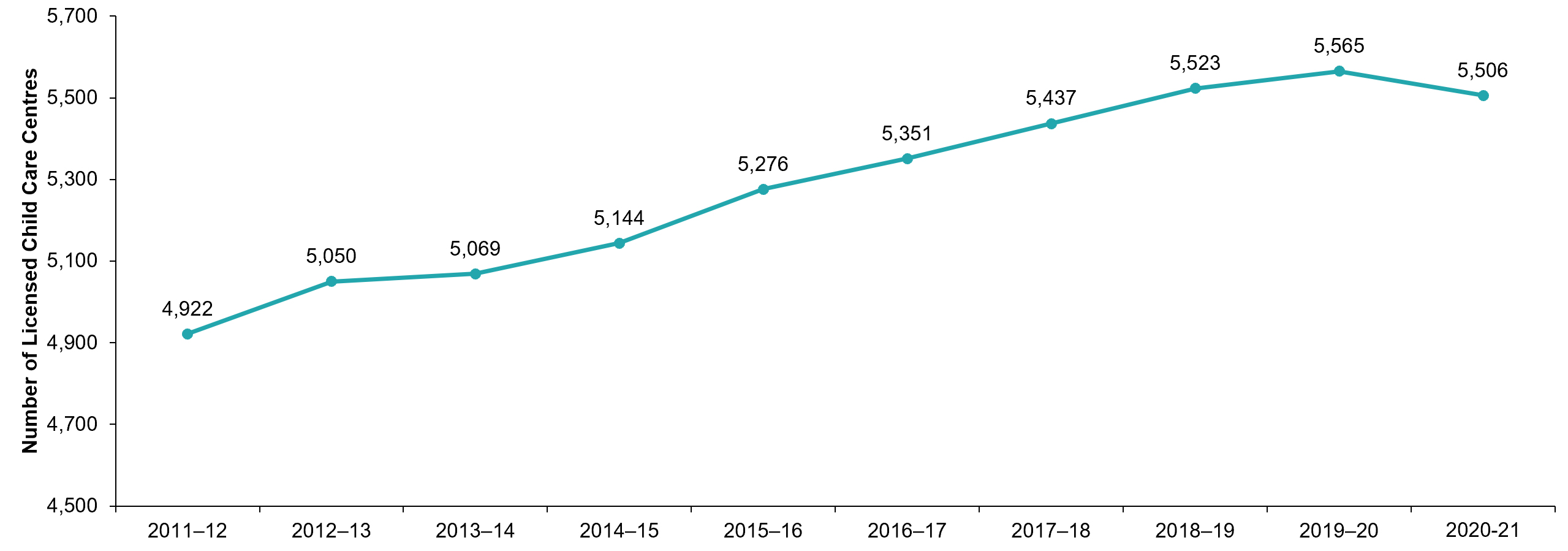
| Year | 2011-12 | 2012-13 | 2013-14 | 2014-15 | 2015-16 | 2016-17 | 2017-18 | 2018-19 | 2019-20 | 2020-21 |
|---|---|---|---|---|---|---|---|---|---|---|
| Number of Centres | 4,922 | 5,050 | 5,069 | 5,144 | 5,276 | 5,351 | 5,437 | 5,523 | 5,565 | 5,506 |
Data source: Child Care Licensing System, Ontario Ministry of Education (as of March 31 each year).
Table 1: Spaces in licensed child care centres by age group, 2011-12 to 2020-21
| Year | 2011-12 | 2012-13 | 2013-14 | 2014-15 | 2015-16 | 2016-17 | 2017-18 | 2018-19 | 2019-20 | 2020-21 |
|---|---|---|---|---|---|---|---|---|---|---|
| Number of Spaces | 275,873 | 294,490 | 317,868 | 350,801 | 389,286 | 406,395 | 427,032 | 446,596 | 462,802 | 464,538 |
| Infant | 9,269 | 9,634 | 10,250 | 11,025 | 11,759 | 12,231 | 12,755 | 13,626 | 14,151 | 14,602 |
| Toddler | 30,867 | 32,578 | 34,772 | 37,833 | 41,211 | 42,900 | 44,529 | 46,865 | 48,858 | 49,883 |
| Preschool | 103,474 | 102,731 | 102,133 | 102,380 | 104,802 | 105,955 | 108,375 | 112,042 | 115,001 | 115,431 |
| Kindergarten | 32,547 | 40,796 | 52,168 | 64,340 | 85,014 | 92,035 | 98,310 | 103,308 | 107,260 | 107,453 |
| School age | 99,743 | 108,795 | 118,545 | 135,223 | 146,500 | 153,274 | 162,901 | 170,337 | 176,840 | 176,327 |
| Family age group | - | - | - | - | - | - | 162 | 418 | 692 | 842 |
Data source: Child Care Licensing System, Ontario Ministry of Education (as of March 31 each year).
Overall, the number of approved homes has increased by 39% since 2011-12, from 6,142 to 8,561 (see the line in Figure 4a), and the number of licensed home child care agencies has increased by 5%, from 132 to 139 (see the bars in Figure 4b).
Figure 4a: Approved homes, 2011-12 to 2020-21
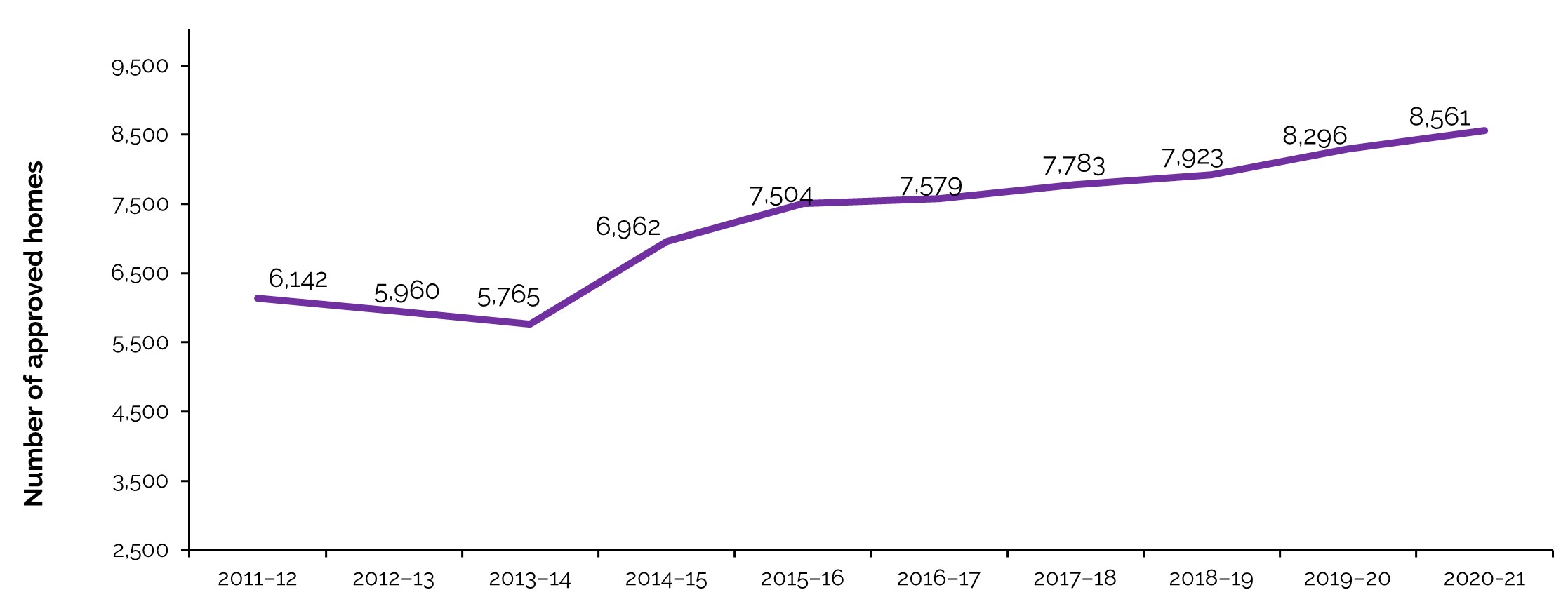
Figure 4b: Licensed home child care agencies, 2011-12 to 2020-21
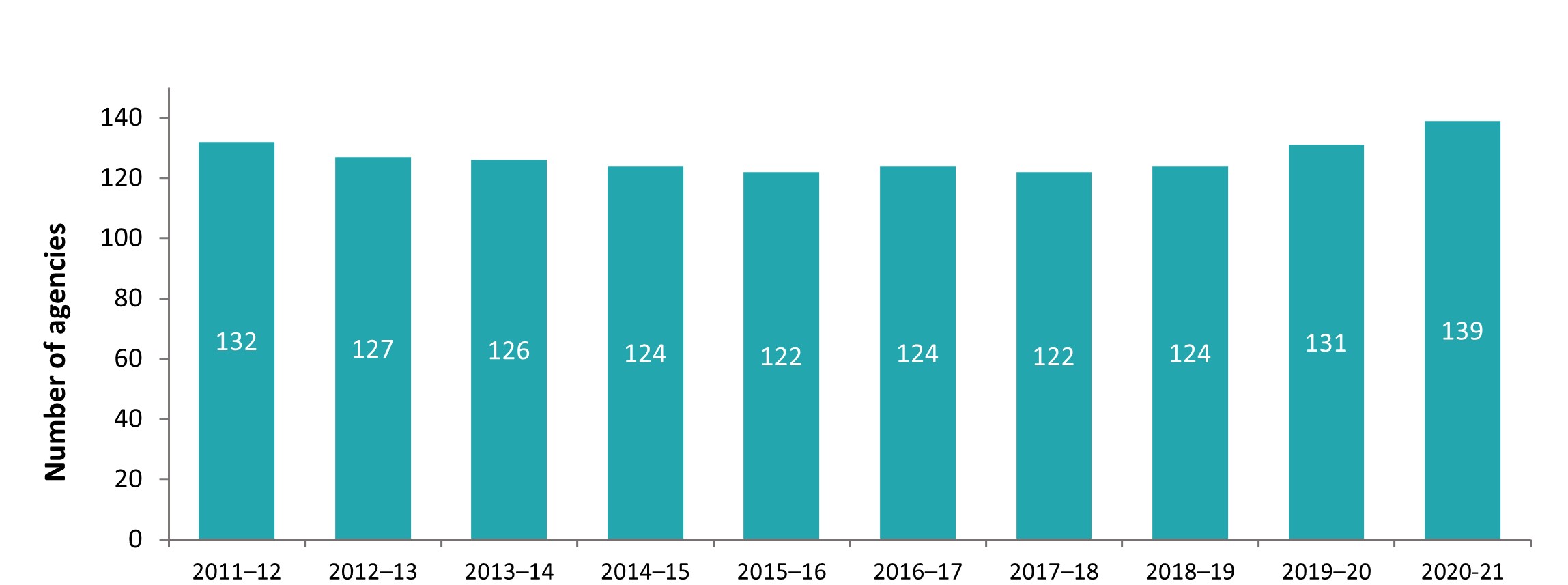
| Year | 2011-12 | 2012-13 | 2013-14 | 2014-15 | 2015-16 | 2016-17 | 2017-18 | 2018-19 | 2019-20 | 2020-21 |
|---|---|---|---|---|---|---|---|---|---|---|
| Number of approved homes | 6,142 | 5,960 | 5,765 | 6,962 | 7,504 | 7,579 | 7,783 | 7,923 | 8,296 | 8,561 |
| Number of agencies | 132 | 127 | 126 | 124 | 122 | 124 | 122 | 124 | 131 | 139 |
Data source: Child Care Licensing System, Ontario Ministry of Education (as of March 31 each year).
Child care by type of auspicefootnote 6
As of March 31, 2021:
- 75.2% of licensed child care centres were not-for-profit (operated by not-for-profit organizations and First Nations) and 24.8% were for-profit
- 78.9% of child care spaces were in not-for-profit centres and 21.1% were in for-profit centres
- 76.3% of licensed home child care agencies were not-for-profit and 23.7% were for-profit
- 85.3% of approved child care homes were affiliated with not-for-profit agencies and 14.7% were affiliated with for-profit agencies
For more detailed data and a look at changes over time, see Table 2 and Table 3.
Table 2: Licensed child care centres and spaces in licensed child care centres by auspice, 2011-12 to 2020-21
| Year | 2011-12 | 2012-13 | 2013-14 | 2014-15 | 2015-16 | 2016-17 | 2017-18 | 2018-19 | 2019-20 | 2020-21 |
|---|---|---|---|---|---|---|---|---|---|---|
| Number of centres | 4,922 | 5,050 | 5,069 | 5,144 | 5,276 | 5,351 | 5,437 | 5,523 | 5,565 | 5,506 |
| Not-for-profit | 3,733 | 3,859 | 3,847 | 3,942 | 4,007 | 4,053 | 4,128 | 4,186 | 4,187 | 4,138 |
| For-profit | 1,189 | 1,191 | 1,222 | 1,202 | 1,269 | 1,298 | 1,309 | 1,337 | 1,378 | 1,368 |
| Number of spaces | 275,873 | 294,490 | 317,868 | 350,801 | 389,286 | 406,395 | 427,032 | 446,596 | 462,802 | 464,538 |
| Not-for-profit | 205,777 | 222,851 | 240,881 | 272,899 | 305,317 | 319,608 | 337,318 | 352,949 | 365,653 | 366,609 |
| For-profit | 70,096 | 71,639 | 76,987 | 77,902 | 83,969 | 86,787 | 89,714 | 93,647 | 97,149 | 97,929 |
Data source: Child Care Licensing System, Ontario Ministry of Education (as of March 31 each year).
Table 3: Licensed home child care agencies and approved homes by auspice, 2011-12 to 2020-21
| Year | 2011-12 | 2012-13 | 2013-14 | 2014-15 | 2015-16 | 2016-17 | 2017-18 | 2018-19 | 2019-20 | 2020-21 |
|---|---|---|---|---|---|---|---|---|---|---|
| Number of agencies | 132 | 127 | 126 | 124 | 122 | 124 | 122 | 124 | 131 | 139 |
| Not-for-profit | 118 | 116 | 113 | 111 | 108 | 109 | 105 | 104 | 105 | 106 |
| For-profit | 14 | 11 | 13 | 13 | 14 | 15 | 17 | 20 | 26 | 33 |
| Number of approved homes | 6,142 | 5,960 | 5,765 | 6,962 | 7,504 | 7,579 | 7,783 | 7,923 | 8,296 | 8,561 |
| Not-for-profit | 5,812 | 5,640 | 5,403 | 6,500 | 6,992 | 7,017 | 7,114 | 7,148 | 7,320 | 7,305 |
| For-profit | 330 | 320 | 362 | 462 | 512 | 562 | 669 | 775 | 976 | 1,256 |
Data source: Child Care Licensing System, Ontario Ministry of Education (as of March 31 each year).
Licensed child care centres – openings and closures
Licensed child care centres open and close on a regular basis (that is, not related to the COVID‑19 pandemic) with more centres opening than closing in most years. Child care centres open for reasons such as the expansion of an existing program, a desire to provide a child care service in a community or local planning efforts by municipalities to address an increase in the need for child care. Centres that close typically do so due to low enrolment.
In 2020-21, 184 child care centres opened and 243 closed. On average, there has been an annual net increase of 71 centres per year for the past 10 years (see Figure 5). 584 more child care centres were in operation over the past ten years.
Figure 5: Licensed child care centre openings and closures, 2011-12 to 2020-21
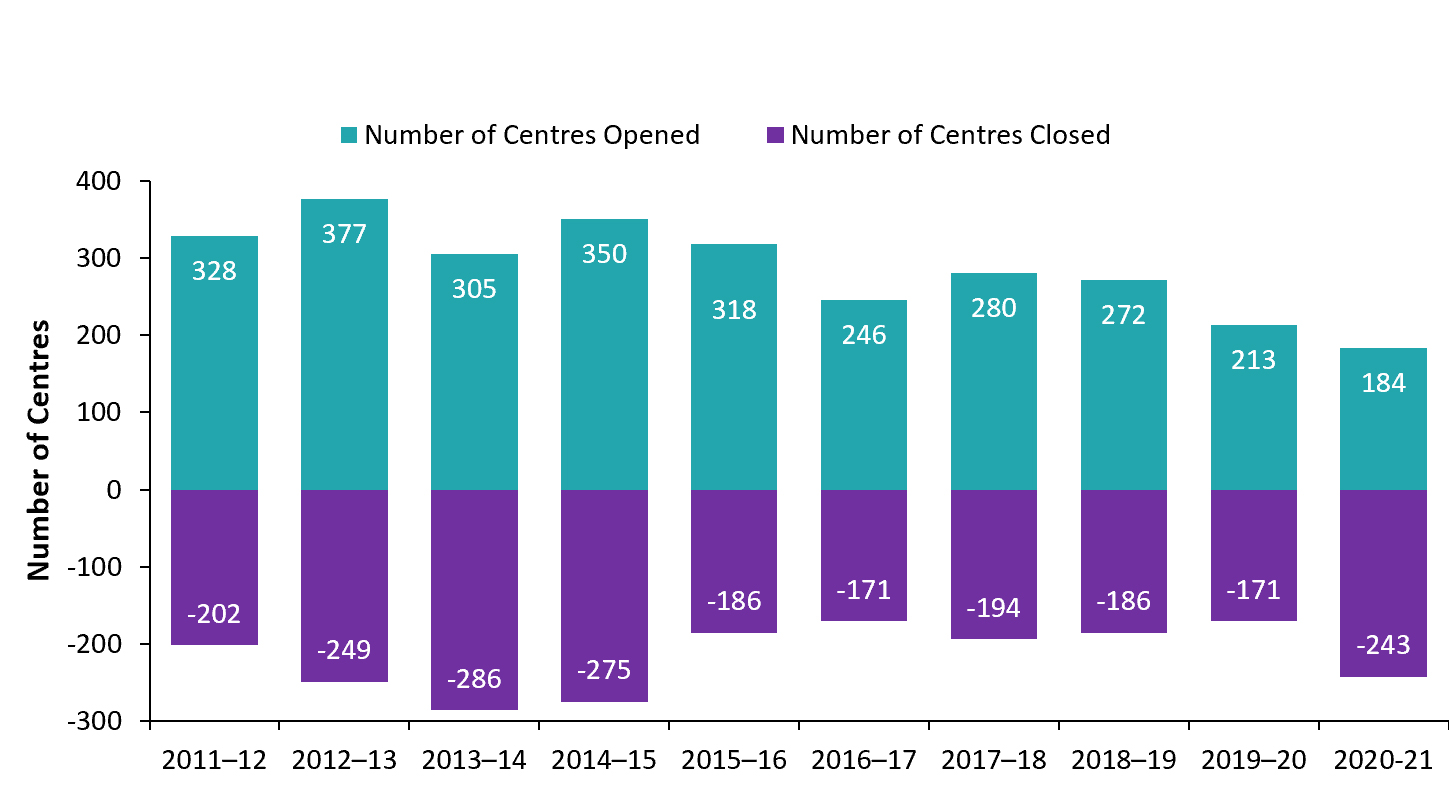
| Year | 2011-12 | 2012-13 | 2013-14 | 2014-15 | 2015-16 | 2016-17 | 2017-18 | 2018-19 | 2019-20 | 2020-21 |
|---|---|---|---|---|---|---|---|---|---|---|
| Number of centres opened | 328 | 377 | 305 | 350 | 318 | 246 | 280 | 272 | 213 | 184 |
| Number of centres closed | -202 | -249 | -286 | -275 | -186 | -171 | -194 | -186 | -171 | -243 |
Data source: Child Care Licensing System, Ontario Ministry of Education (as of March 31 each year).
Licensed child care in publicly funded schools and in communities
As of March 31, 2021, 54% of child care centres and 64% of child care spaces were in publicly funded schools. The remaining 46% of child care centres and 36% of child care spaces were located elsewhere in the community. The number of licensed child care centres located in publicly funded schools decreased by 0.6% in 2020-21 compared to the previous year and spaces increased by 0.5% in the same period. Since 2011-12, the number of child care centres located in publicly funded schools has increased by 30% (see Figure 6), and spaces have increased by 137% (see Figure 7).
Figure 6: Licensed child care centres in publicly funded schools and in communities, 2011-12 to 2020-21
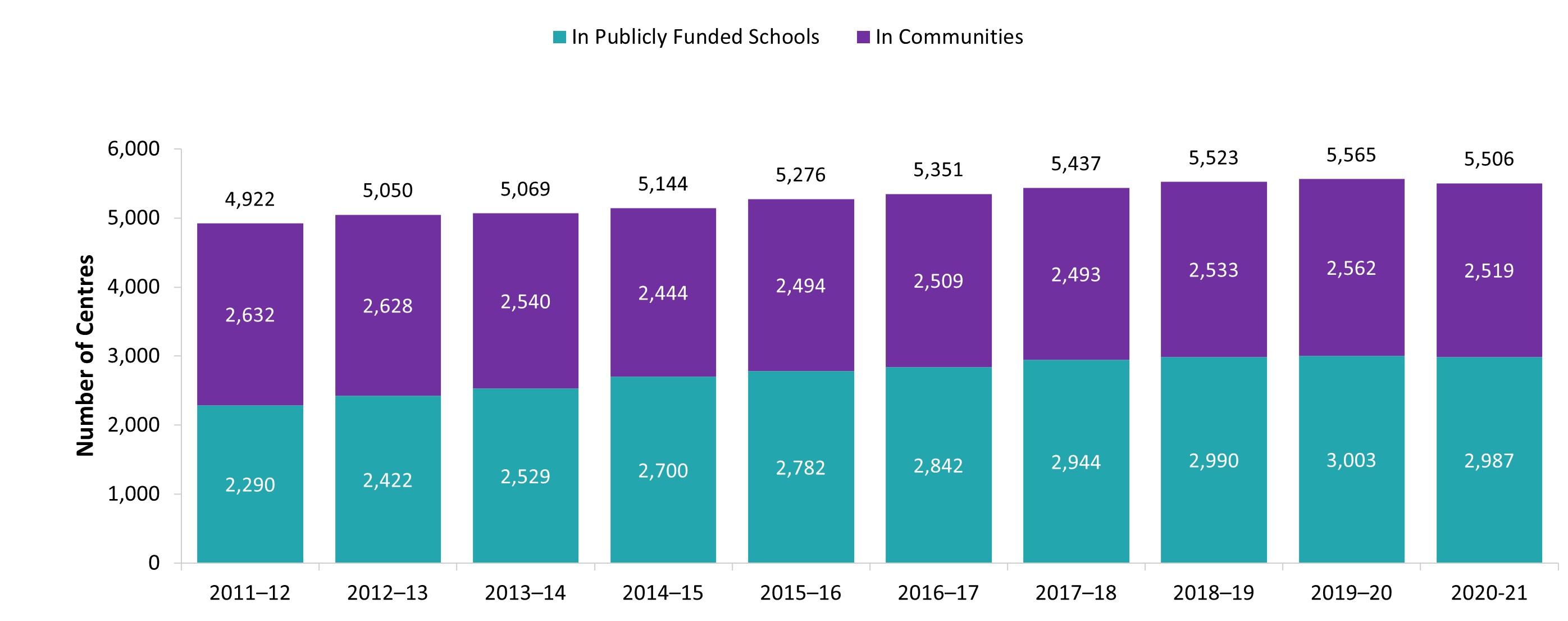
| Year | 2011-12 | 2012-13 | 2013-14 | 2014-15 | 2015-16 | 2016-17 | 2017-18 | 2018-19 | 2019-20 | 2020-21 |
|---|---|---|---|---|---|---|---|---|---|---|
| In publicly funded schools | 2,290 | 2,422 | 2,529 | 2,700 | 2,782 | 2,842 | 2,944 | 2,990 | 3,003 | 2,987 |
| In communities | 2,632 | 2,628 | 2,540 | 2,444 | 2,494 | 2,509 | 2,493 | 2,533 | 2,562 | 2,519 |
| Total | 4,922 | 5,050 | 5,069 | 5,144 | 5,276 | 5,351 | 5,437 | 5,523 | 5,565 | 5,506 |
Data source: Child Care Licensing System, Ontario Ministry of Education (as of March 31 each year).
Figure 7: Licensed child care spaces in publicly funded schools and in communities, 2011-12 to 2020-21
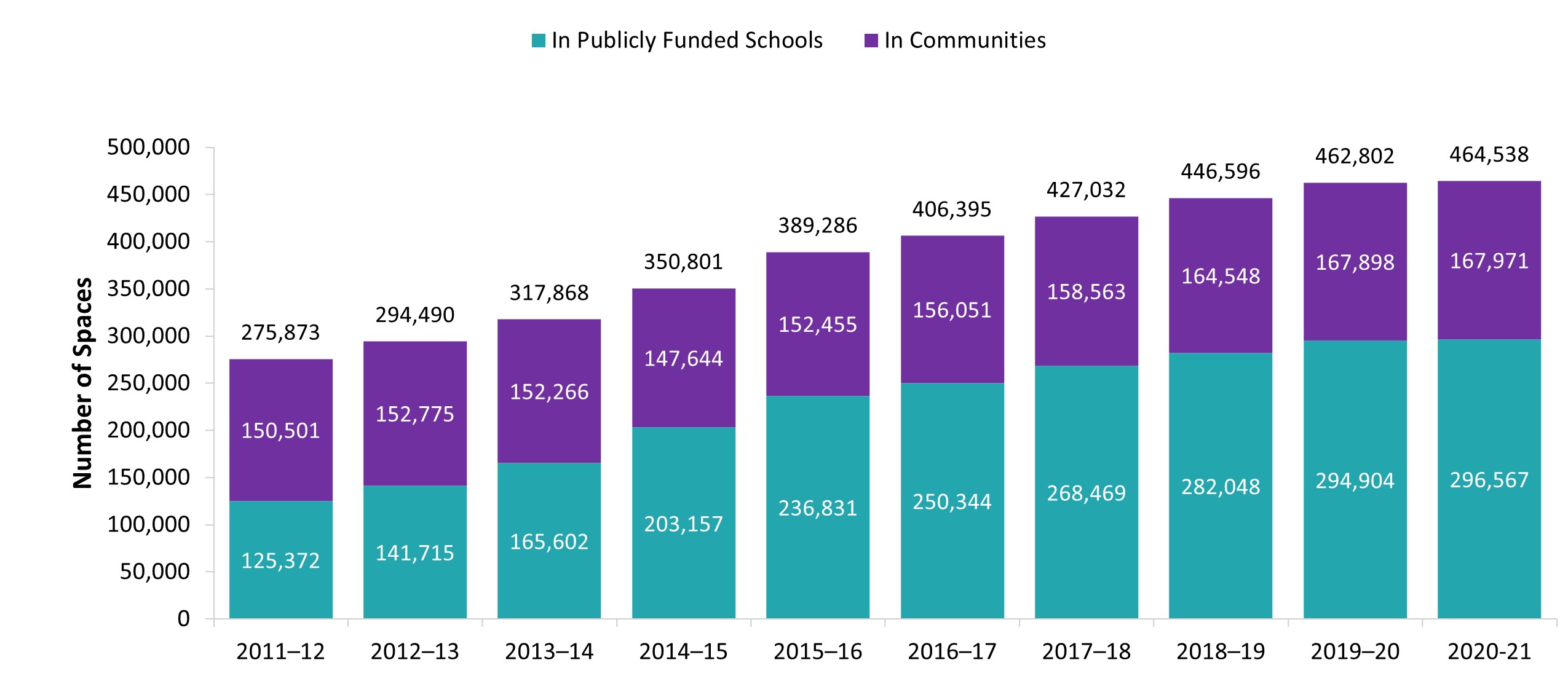
| Year | 2011-12 | 2012-13 | 2013-14 | 2014-15 | 2015-16 | 2016-17 | 2017-18 | 2018-19 | 2019-20 | 2020-21 |
|---|---|---|---|---|---|---|---|---|---|---|
| In publicly funded schools | 125,372 | 141,715 | 165,602 | 203,157 | 236,831 | 250,344 | 268,469 | 282,048 | 294,904 | 296,567 |
| In communities | 150,501 | 152,775 | 152,266 | 147,644 | 152,455 | 156,051 | 158,563 | 164,548 | 167,898 | 167,971 |
| Total | 275,873 | 294,490 | 317,868 | 350,801 | 389,286 | 406,395 | 427,032 | 446,596 | 462,802 | 464,538 |
Data source: Child Care Licensing System, Ontario Ministry of Education (as of March 31 each year).
First Nations licensed child care on reserve
As of March 31, 2021, 74 licensed child care centres were operating on 59 First Nations in Ontario. The number of licensed child care spaces on reserve has increased by 5% since 2011-12 (see Table 4).
Table 4: First Nations licensed child care centres and spaces by age group, 2011-12 to 2020-21
| Year | 2011-12 | 2012-13 | 2013-14 | 2014-15 | 2015-16 | 2016-17 | 2017-18 | 2018-19 | 2019-20 | 2020-21 |
|---|---|---|---|---|---|---|---|---|---|---|
| Number of centres | 76 | 76 | 74 | 75 | 76 | 76 | 76 | 75 | 75 | 74 |
| Infant | 223 | 232 | 254 | 270 | 296 | 290 | 290 | 290 | 309 | 309 |
| Toddler | 682 | 692 | 702 | 727 | 727 | 727 | 731 | 717 | 747 | 747 |
| Preschool | 1,602 | 1,624 | 1,620 | 1,568 | 1,541 | 1,553 | 1,551 | 1,529 | 1,584 | 1,568 |
| Kindergarten | 197 | 205 | 172 | 177 | 192 | 192 | 227 | 225 | 228 | 208 |
| School age | 439 | 458 | 443 | 398 | 413 | 413 | 416 | 413 | 459 | 459 |
| Family age | - | - | - | - | - | - | - | 15 | 15 | 15 |
| Total number of spaces | 3,143 | 3,211 | 3,191 | 3,140 | 3,169 | 3,175 | 3,215 | 3,189 | 3,342 | 3,306 |
Data source: Child Care Licensing System, Ontario Ministry of Education (as of March 31 each year).
French-language and bilingual licensed child care
Some licensed child care centres offer services in French or in both English and French (bilingual). In 2020-21, of the 5,506 licensed child care centres, 307 (6%) offered programs in French and 97 (2%) offered bilingual programs. Of the 464,538 licensed child care spaces, 35,463 (8%) were for programs in French and 7,237 (2%) were for bilingual programs. For further details about how these spaces are distributed by age, see Figure 8.
Figure 8: Licensed child care spaces in French-language and bilingual child care by age group, 2020-21
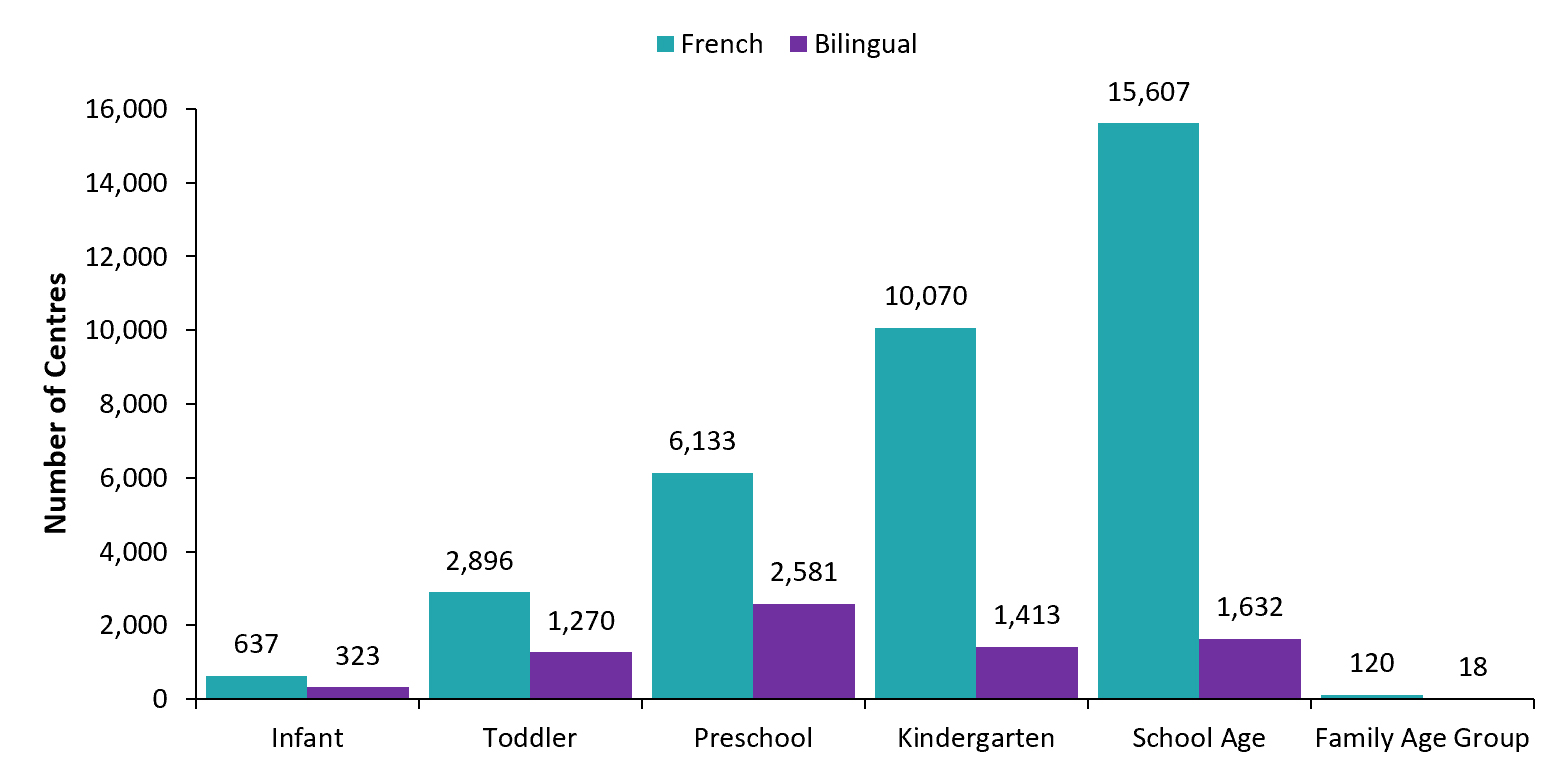
| Age | French | Bilingual |
|---|---|---|
| Infant | 637 | 323 |
| Toddler | 2,896 | 1,270 |
| Preschool | 6,133 | 2,581 |
| Kindergarten | 10,070 | 1,413 |
| School age | 15,607 | 1,632 |
| Family age group | 120 | 18 |
Data source: Child Care Licensing System, Ontario Ministry of Education (as of March 31 each year).
Parent fees by age group
In 2021, the most recent year for which data is available, median parent fees among licensed child care centres ranged from $69 per day for infants to $22 per day for school-aged children. Median parent fees among licensed home child care agencies ranged from $47 per day for children under two years of age to $25 per day for children aged six to 12 years.
Licensed child care continues to be more expensive for younger children than it is for older children. In general, daily parent fees for younger children were higher among licensed child care centres than home child care agencies. Fees for older children were lower in licensed child care centres compared to home child care agencies (see Figures 9 and 10).
Figure 9: Median daily fees by age group among licensed child care centres, 2021
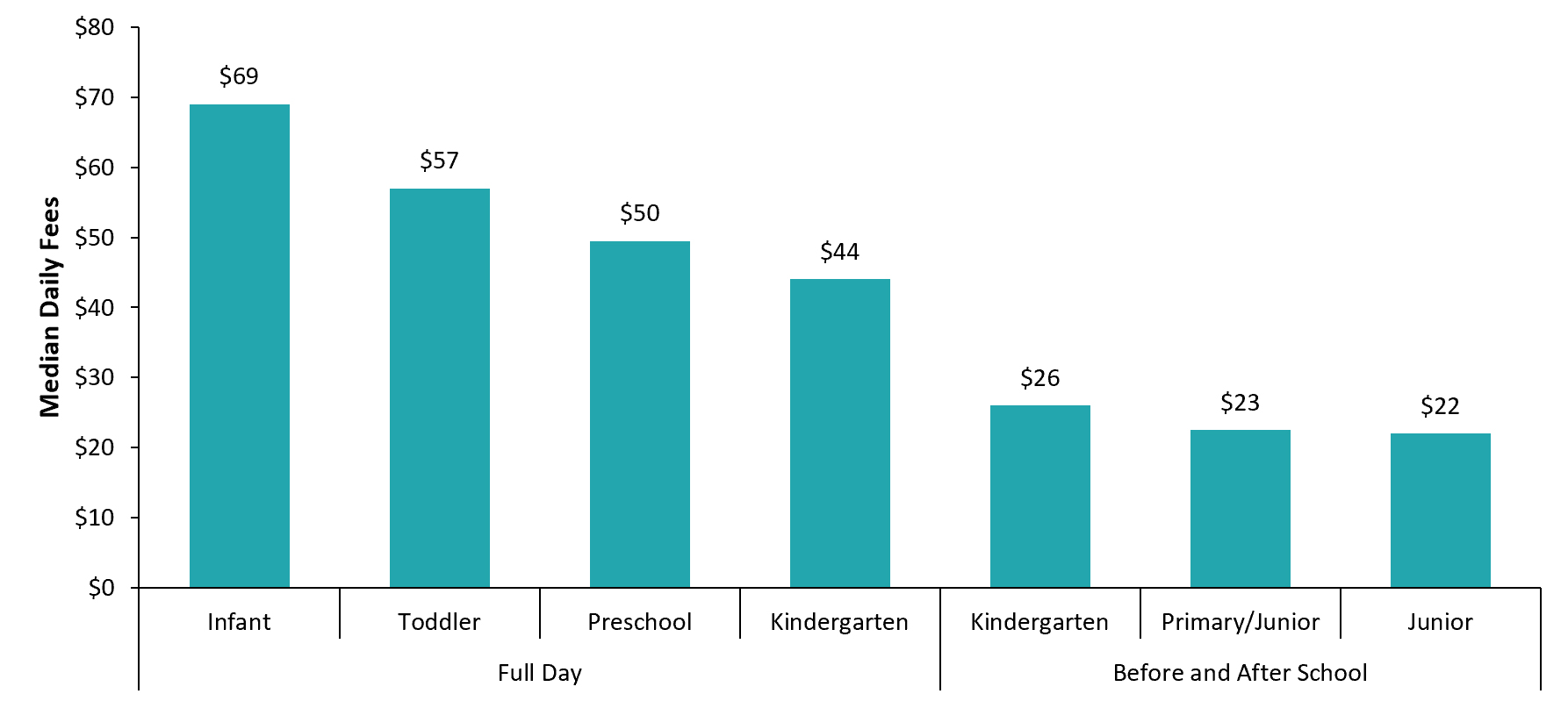
| Infant | Toddler | Preschool | Kindergarten |
|---|---|---|---|
| $69 | $57 | $50 | $44 |
| Kindergarten | Primary/junior | Junior |
|---|---|---|
| $26 | $23 | $22 |
Data source: 2021 Licensed Child Care Operations Survey, Ontario Ministry of Education (as of March 31, 2021).
Figure 10: Median daily fees by age group among licensed home child care agencies, 2021
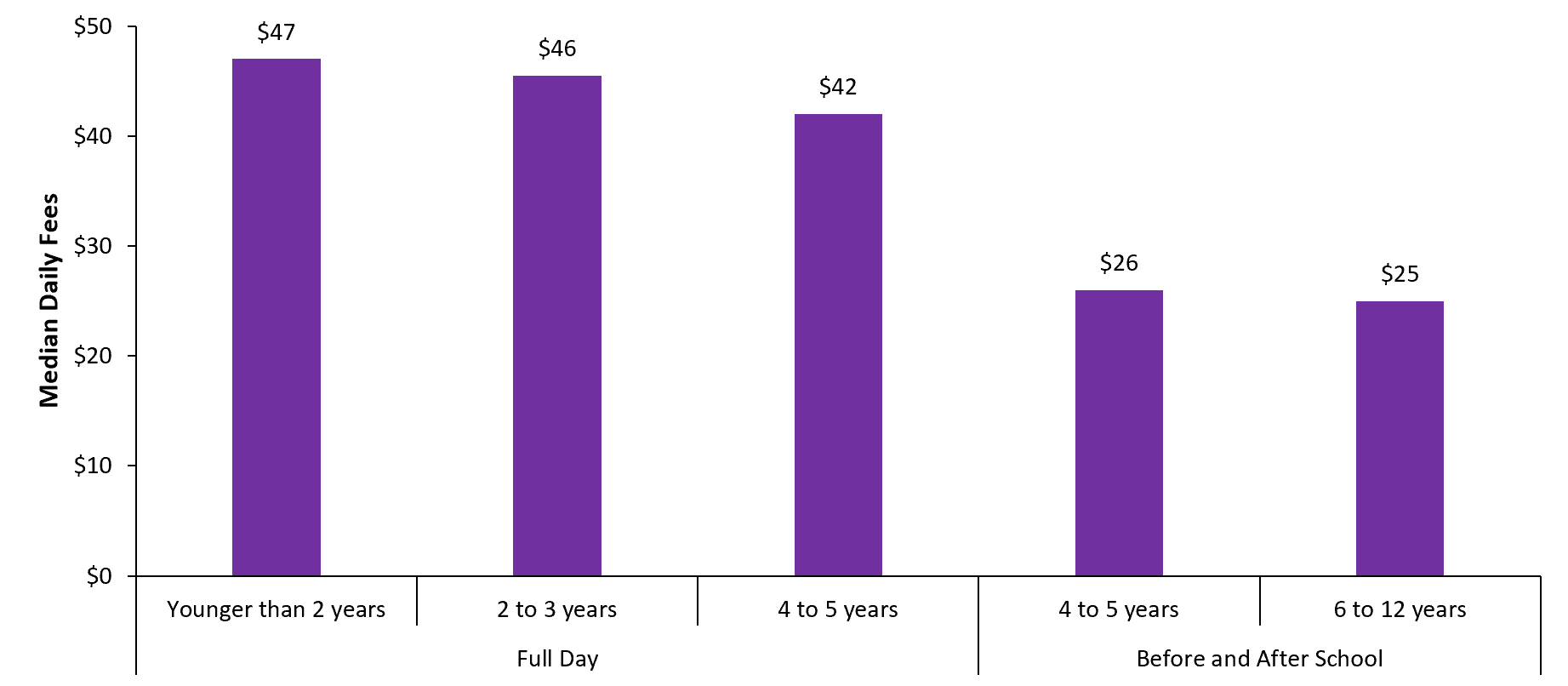
| Younger than 2 years | 2 to 3 years | 4 to 5 years |
|---|---|---|
| $47 | $46 | $42 |
| 4 to 5 years | 6 to 12 years |
|---|---|
| $26 | $25 |
Data source: 2021 Licensed Child Care Operations Survey, Ontario Ministry of Education (as of March 31, 2021).
Staff wages by category
Program staff fall into one of three categories: Registered Early Childhood Educators (RECEs), staff approved by a ministry director
Figure 11: Hourly wages of full-time program staff in licensed child care centres, 2021
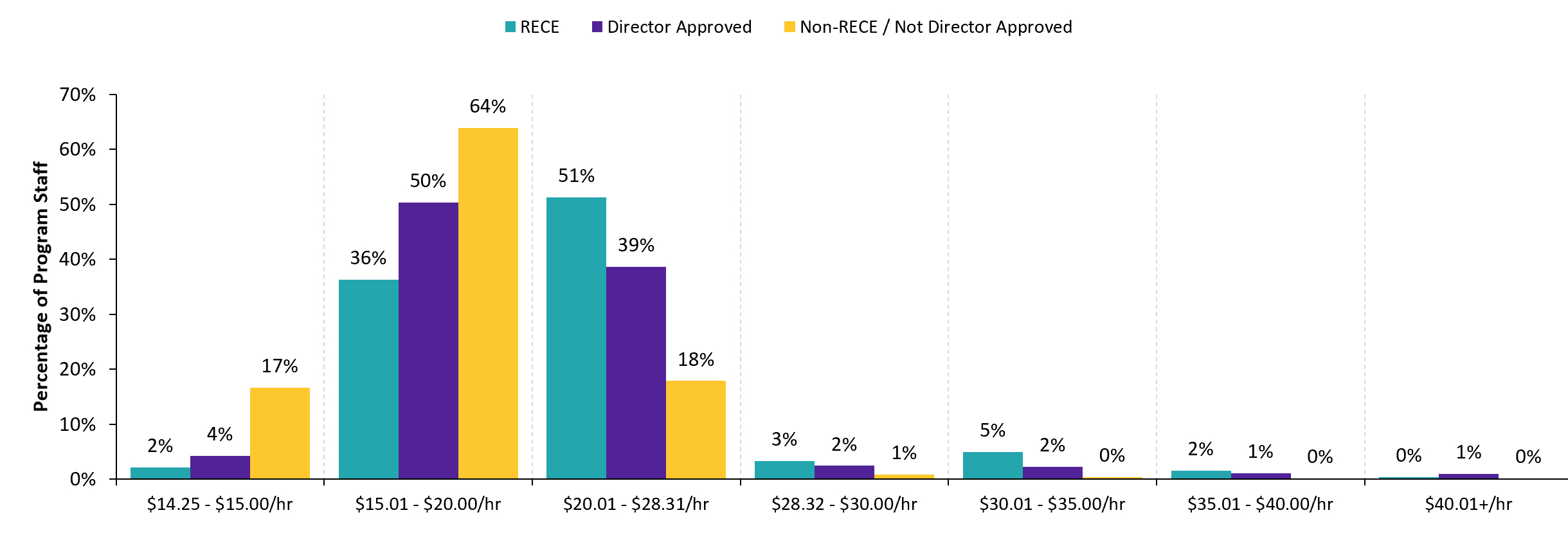
| Wage range | RECE | Director approved | Non-RECE/not director approved |
|---|---|---|---|
| $14.25-$15.00 | 2% | 4% | 17% |
| $15.01-$20.00 | 36% | 50% | 64% |
| $20.01-$28.31 | 51% | 39% | 18% |
| $28.32-$30.00 | 3% | 2% | 1% |
| $30.01-$35.00 | 5% | 2% | 0% |
| $35.01-$40.00 | 2% | 1% | 0% |
| $40.01+ | 0% | 1% | 0% |
Data source: 2021 Licensed Child Care Operations Survey, Ontario Ministry of Education (as of March 31, 2021).
COVID and licensed child care footnote 9
On March 1, 2020, 92% of licensed child care centres reported that they were providing care to children. This percentage declined to 21% on June 30, 2020 and later increased to 59% on August 31, 2020, 96% on December 31, 2020 and 97% the following year on March 31, 2021 (see Figure 12). For licensed home child care agencies, around 90% reported that care was being provided to children on March 1, 2020, August 31, 2020, December 31, 2020, and the following year on March 31, 2021. The percentage was 69% on June 30, 2020 (see Figure 13).
Figure 12: Percentage of licensed child care centres providing care in 2020-2021
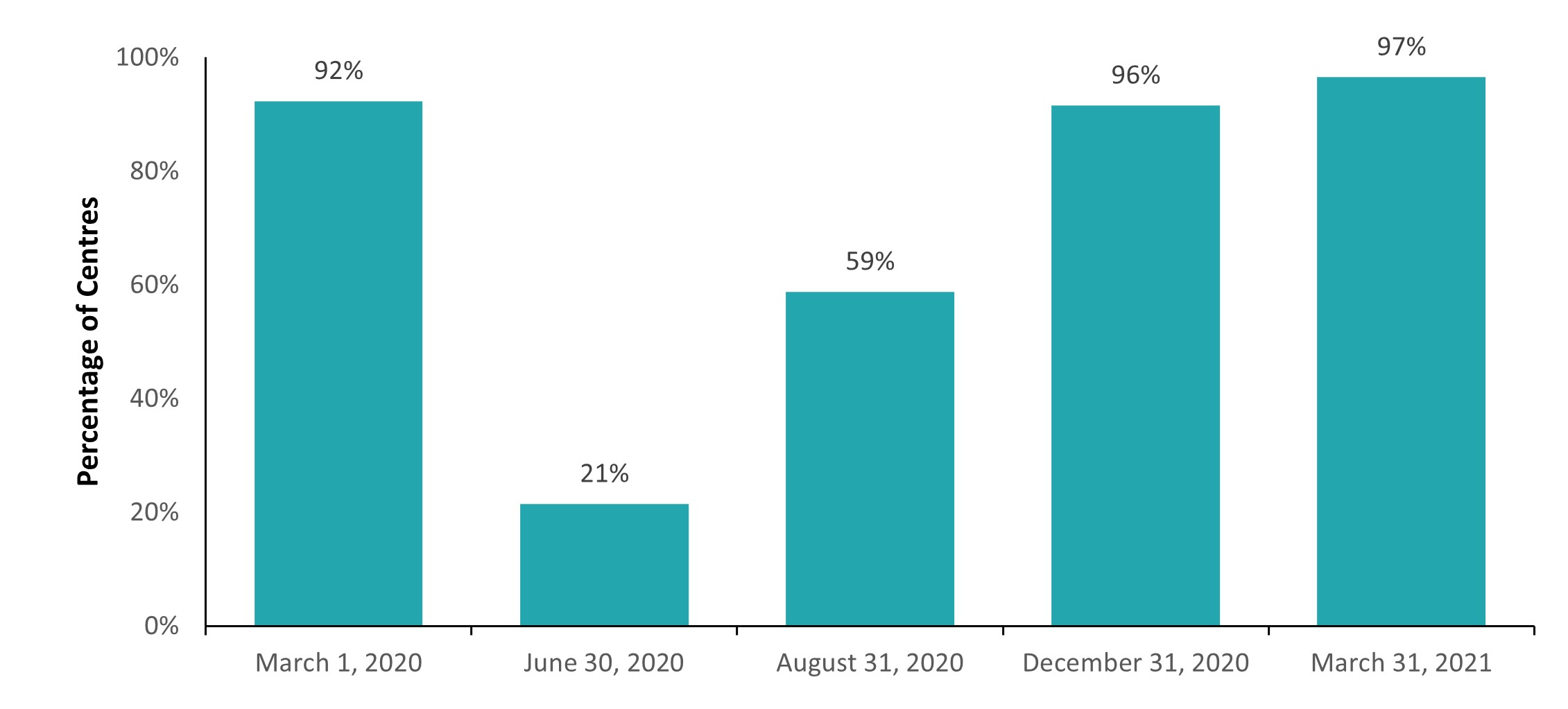
| March 2020 | June 2020 | August 2020 | December 2020 | March 2021 | |
|---|---|---|---|---|---|
| Percentage of Centres | 92% | 21% | 59% | 96% | 97% |
Data source: 2021 Licensed Child Care Operations Survey, Ontario Ministry of Education and Child Care Licensing System.
Figure 13: Percentage of home child care agencies providing care in 2020-2021
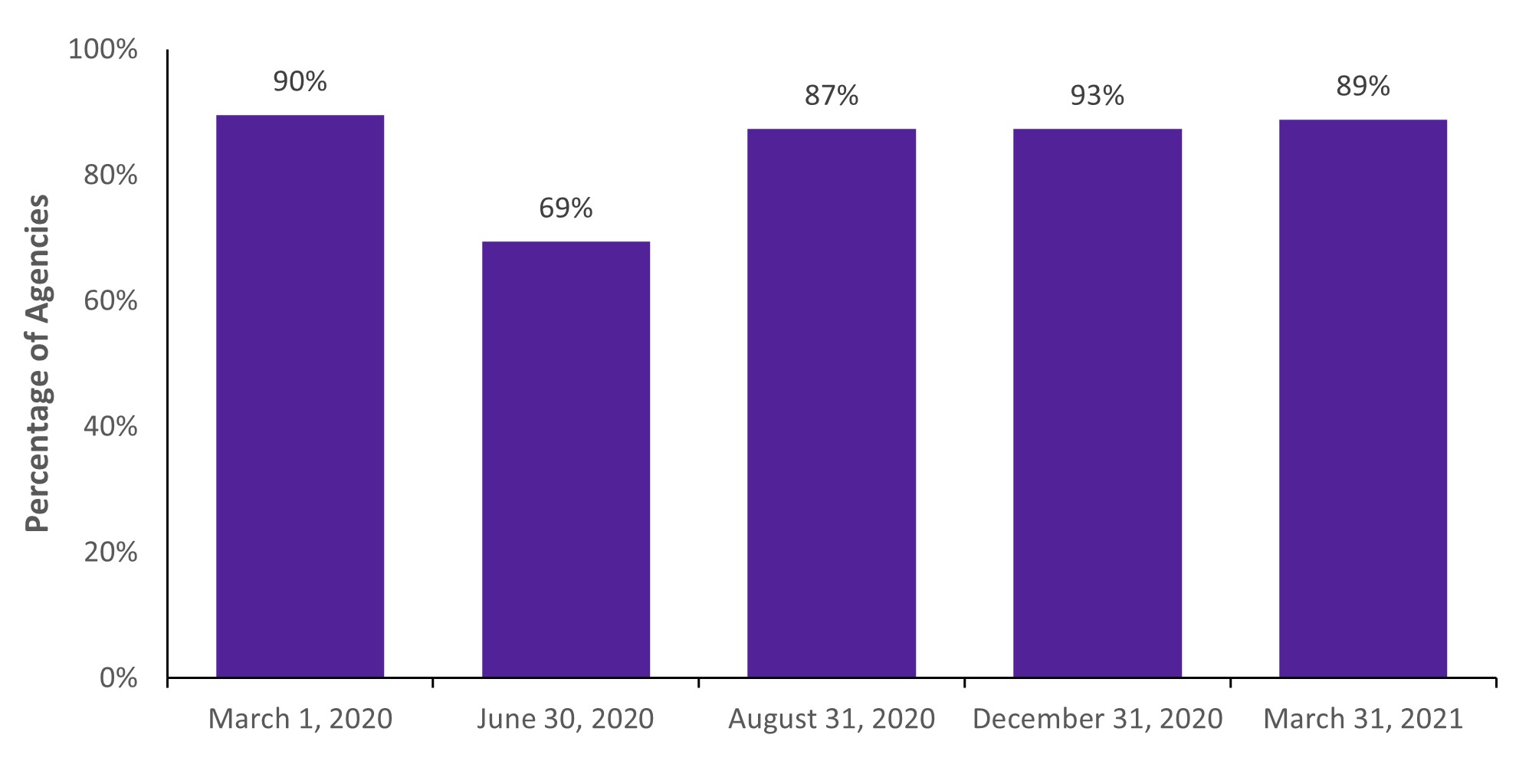
| March 2020 | June 2020 | August 2020 | December 2020 | March 2021 | |
|---|---|---|---|---|---|
| Percentage of Agencies | 90% | 69% | 87% | 93% | 89% |
Data source: 2021 Licensed Child Care Operations Survey, Ontario Ministry of Education and Child Care Licensing System.
EarlyON Child and Family Centres
EarlyON Child and Family Centres offer free drop-in programs for caregivers and children from birth to six years old. The centres are open to all families in Ontario and offer a range of services:
- activities such as reading, storytelling, games and sing-alongs
- advice from professionals trained in early childhood development
- information about other family services in the community
- opportunities to connect with other families with young children
The ministry’s EarlyON Child and Family Centre web page allows parents and caregivers to find child and family programs in their communities.
The CMSMs and DSSABs assumed responsibility for EarlyON Child and Family Centres in January 2018. These service system managers are responsible for the local management of EarlyON centres as part of their responsibility for the management of child care and other human services.
As of March 2021, there were 1,083 EarlyON Child and Family Centre locations across Ontario, of which 419 were main EarlyON Child and Family Centre locations and 664 were mobile/satellite EarlyON Child and Family Centre locations. In addition, there were 198 EarlyON Child and Family Centres offering virtual services and supports to meet the needs of families across the province.
Of the total number of EarlyON Child and Family Centre locations, 381 offer non-standard hours, 132 offer French-language programming, and 176 offer Indigenous programming.
Indigenous-led programs and programs on reserve
As part of Ontario’s commitment to reconciliation with Indigenous peoples, the ministry established or enhanced 65 programs in First Nation communities (five enhanced and 60 new child and family programs) and 61 programs in urban and rural communities (10 child care programs, 14 joint child care and child and family programs, and 37 child and family programs). See Figure 14.
Figure 14: Indigenous-led child care and child and family programs
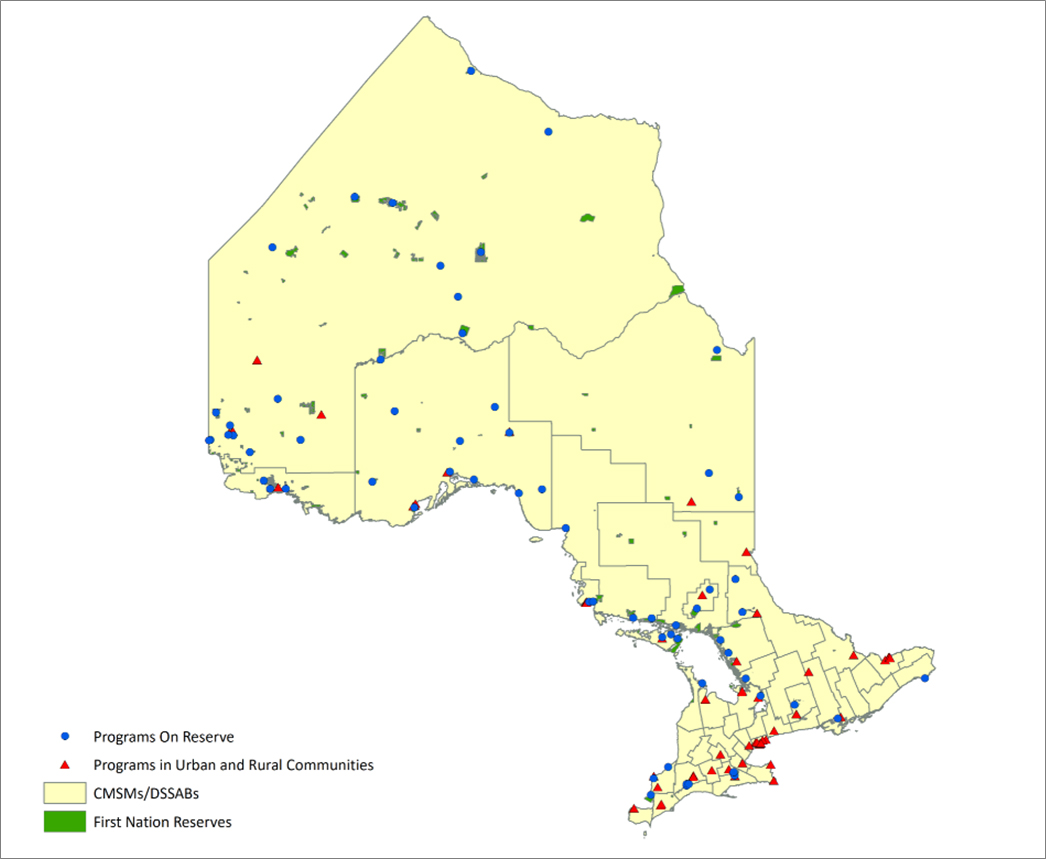
| Key | Longitude | Latitude |
|---|---|---|
| Program on reserve | -88.51612547 | 52.74551493 |
| Program on reserve | -88.01144188 | 52.20458408 |
| Program on reserve | -94.54344008 | 49.89244761 |
| Program on reserve | -82.49335912 | 42.59193425 |
| Program on reserve | -92.94053167 | 48.7109575 |
| Program on reserve | -80.07211576 | 46.97319544 |
| Program on reserve | -85.42101384 | 55.00878088 |
| Program on reserve | -80.83297866 | 49.00291299 |
| Program on reserve | -81.77602623 | 46.06616388 |
| Program on reserve | -79.77738263 | 44.99468503 |
| Program on reserve | -94.44642813 | 49.70772064 |
| Program on reserve | -84.92716448 | 47.961158 |
| Program on reserve | -90.22974745 | 51.09183391 |
| Program on reserve | -90.46931484 | 48.83889662 |
| Program on reserve | -94.94315428 | 50.12991664 |
| Program on reserve | -87.88806256 | 51.55889818 |
| Program on reserve | -79.87386116 | 46.3234159 |
| Program on reserve | -88.24532269 | 49.02890794 |
| Program on reserve | -77.14140526 | 44.18573017 |
| Program on reserve | -79.9743632 | 48.55009597 |
| Program on reserve | -80.81123652 | 46.77296054 |
| Program on reserve | -80.0951481 | 43.00001813 |
| Program on reserve | -87.55723745 | 48.88316696 |
| Program on reserve | -82.4681282 | 46.20206599 |
| Program on reserve | -92.52151557 | 49.62547562 |
| Program on reserve | -87.63473886 | 55.99066182 |
| Program on reserve | -86.95750847 | 50.23219119 |
| Program on reserve | -84.26152431 | 46.52850474 |
| Program on reserve | -81.46830082 | 42.78799233 |
| Program on reserve | -81.47338783 | 42.81898334 |
| Program on reserve | -93.17646179 | 50.37951434 |
| Program on reserve | -80.13569874 | 43.05518218 |
| Program on reserve | -87.95905849 | 49.60261504 |
| Program on reserve | -81.91557368 | 45.8833198 |
| Program on reserve | -84.15020002 | 46.53684933 |
| Program on reserve | -90.97214707 | 53.92403858 |
| Program on reserve | -82.4160557 | 42.93599504 |
| Program on reserve | -95.09931025 | 49.62564713 |
| Program on reserve | -80.27345222 | 45.51398427 |
| Program on reserve | -80.50075679 | 45.76940789 |
| Program on reserve | -93.38618264 | 48.711037 |
| Program on reserve | -85.60874046 | 48.69799071 |
| Program on reserve | -80.60051648 | 51.26263272 |
| Program on reserve | -93.57322355 | 48.86138288 |
| Program on reserve | -74.64541366 | 44.99974921 |
| Program on reserve | -94.58714442 | 49.7145092 |
| Program on reserve | -81.40975981 | 42.81942534 |
| Program on reserve | -81.72808962 | 45.79754173 |
| Program on reserve | -93.97296119 | 49.39471385 |
| Program on reserve | -86.54424226 | 49.75792015 |
| Program on reserve | -89.884895 | 53.823251 |
| Program on reserve | -82.16181733 | 45.82547182 |
| Program on reserve | -78.37530686 | 44.46253162 |
| Program on reserve | -80.11751507 | 43.07040711 |
| Program on reserve | -89.26267604 | 48.35433571 |
| Program on reserve | -81.02682287 | 44.90303172 |
| Program on reserve | -81.99881499 | 43.17839181 |
| Program on reserve | -82.99862836 | 46.20834662 |
| Program on reserve | -81.17876023 | 46.39797902 |
| Program on reserve | -79.35127 | 44.64665803 |
| Program on reserve | -86.26900785 | 48.6260545 |
| Program on reserve | -87.36030342 | 52.98405156 |
| Program on reserve | -93.32765709 | 53.06308805 |
| Program on reserve | -95.13574475 | 49.61399338 |
| Program on reserve | -89.44999142 | 50.28335218 |
| Program in urban and rural community | -93.39832227 | 48.61132804 |
| Program in urban and rural community | -78.96350418 | 43.93533716 |
| Program in urban and rural community | -80.92765221 | 44.57641104 |
| Program in urban and rural community | -79.87588926 | 44.74389203 |
| Program in urban and rural community | -79.41803819 | 44.61291617 |
| Program in urban and rural community | -79.88581525 | 44.72769518 |
| Program in urban and rural community | -80.74319425 | 43.11309514 |
| Program in urban and rural community | -82.40857615 | 42.98944225 |
| Program in urban and rural community | -80.49261705 | 43.44752302 |
| Program in urban and rural community | -82.20892703 | 42.38030109 |
| Program in urban and rural community | -82.18586924 | 42.40422301 |
| Program in urban and rural community | -81.26794702 | 43.00579725 |
| Program in urban and rural community | -75.68618205 | 45.42647824 |
| Program in urban and rural community | -75.77923303 | 45.37325021 |
| Program in urban and rural community | -75.66025703 | 45.43128425 |
| Program in urban and rural community | -75.659067 | 45.43716906 |
| Program in urban and rural community | -76.68922405 | 45.47275509 |
| Program in urban and rural community | -77.05651516 | 44.21782712 |
| Program in urban and rural community | -77.97366606 | 45.140287 |
| Program in urban and rural community | -81.33019412 | 48.47083224 |
| Program in urban and rural community | -82.16362709 | 45.81168823 |
| Program in urban and rural community | -84.35698002 | 46.52043202 |
| Program in urban and rural community | -81.01630709 | 46.66711108 |
| Program in urban and rural community | -79.44893904 | 46.30716523 |
| Program in urban and rural community | -94.48604599 | 49.76570087 |
| Program in urban and rural community | -88.31390084 | 49.02536685 |
| Program in urban and rural community | -86.53493775 | 49.7815039 |
| Program in urban and rural community | -89.2483248 | 48.39443104 |
| Program in urban and rural community | -89.29021099 | 48.38094611 |
| Program in urban and rural community | -94.55887787 | 49.75591696 |
| Program in urban and rural community | -79.3794942 | 43.65327318 |
| Program in urban and rural community | -79.1909611 | 43.75114806 |
| Program in urban and rural community | -79.36982125 | 43.66915502 |
| Program in urban and rural community | -79.28806103 | 43.73860815 |
| Program in urban and rural community | -79.49089212 | 43.68657404 |
| Program in urban and rural community | -79.44843321 | 43.69158513 |
| Program in urban and rural community | -79.33589504 | 43.67922723 |
| Program in urban and rural community | -78.32633613 | 44.27835011 |
| Program in urban and rural community | -78.32217025 | 44.27766513 |
| Program in urban and rural community | -79.86725312 | 43.26275212 |
| Program in urban and rural community | -78.97030809 | 42.89850506 |
| Program in urban and rural community | -80.08328005 | 42.99404603 |
| Program in urban and rural community | -82.97510025 | 42.31501124 |
| Program in urban and rural community | -80.25770417 | 43.13897712 |
| Program in urban and rural community | -79.06098316 | 43.23815325 |
| Program in urban and rural community | -81.27571021 | 42.98130519 |
| Program in urban and rural community | -79.74909406 | 47.50823413 |
| Program in urban and rural community | -94.55887787 | 49.75591696 |
| Program in urban and rural community | -93.75916293 | 51.08648286 |
| Program in urban and rural community | -79.67466303 | 43.63050602 |
| Program in urban and rural community | -79.87518017 | 44.7496091 |
| Program in urban and rural community | -82.29617306 | 42.76310406 |
| Program in urban and rural community | -75.64043202 | 45.41055025 |
| Program in urban and rural community | -80.03478621 | 45.34900601 |
| Program in urban and rural community | -84.31952908 | 46.53269711 |
| Program in urban and rural community | -84.3292741 | 46.51159521 |
| Program in urban and rural community | -79.44893904 | 46.30716523 |
| Program in urban and rural community | -94.45251774 | 49.78325394 |
| Program in urban and rural community | -91.92008182 | 50.098065 |
| Program in urban and rural community | -89.22810985 | 48.43004015 |
| Program in urban and rural community | -80.942178 | 44.568058 |
Data sources: Ontario Ministry of Education; Statistics Canada.
Early years developmental health and well-being
Information on children’s developmental health and well-being prior to Grade 1 is collected throughout the province using the Early Development Instrument (EDI). The EDI is a questionnaire that teachers complete about the skills and abilities of each of their Year 2 (senior) kindergarten students. It measures developmental health and well-being across five domains:
- physical health and well-being
- social competence
- emotional maturity
- language and cognitive development
- communication skills and general knowledge
The EDI is used as a population measure (such as, a measure of whole populations based on geographical or administrative boundaries) by the ministry, municipalities, school boards, and community organizations to inform decision-making and plan early years programs and services. The ministry uses the EDI as a key indicator to monitor the state of young children in Ontario.
Since 2004, the EDI has been collected across the province in three-year cycles:
- over a three-year period for Cycle 1 (2004-06), Cycle 2 (2007-09) and Cycle 3 (2010-12)
- in a single year, every three years, for Cycle 4 (2015) and Cycle 5 (2018)
footnote 11
EDI results can be compared over time to get a sense of how young children’s developmental health and well-being is changing in Ontario. Examining the percentage of vulnerable children
Overall, results remained relatively stable between Cycle 4 and Cycle 5. In 2018, 70.4% of children were considered developmentally ready when they entered Grade 1, compared to 70.6% in 2015.
Additional information about the EDI is available from the Offord Centre for Child Studies at McMaster University.
Figure 15: Percentage of vulnerable children by EDI domain, 2004-18
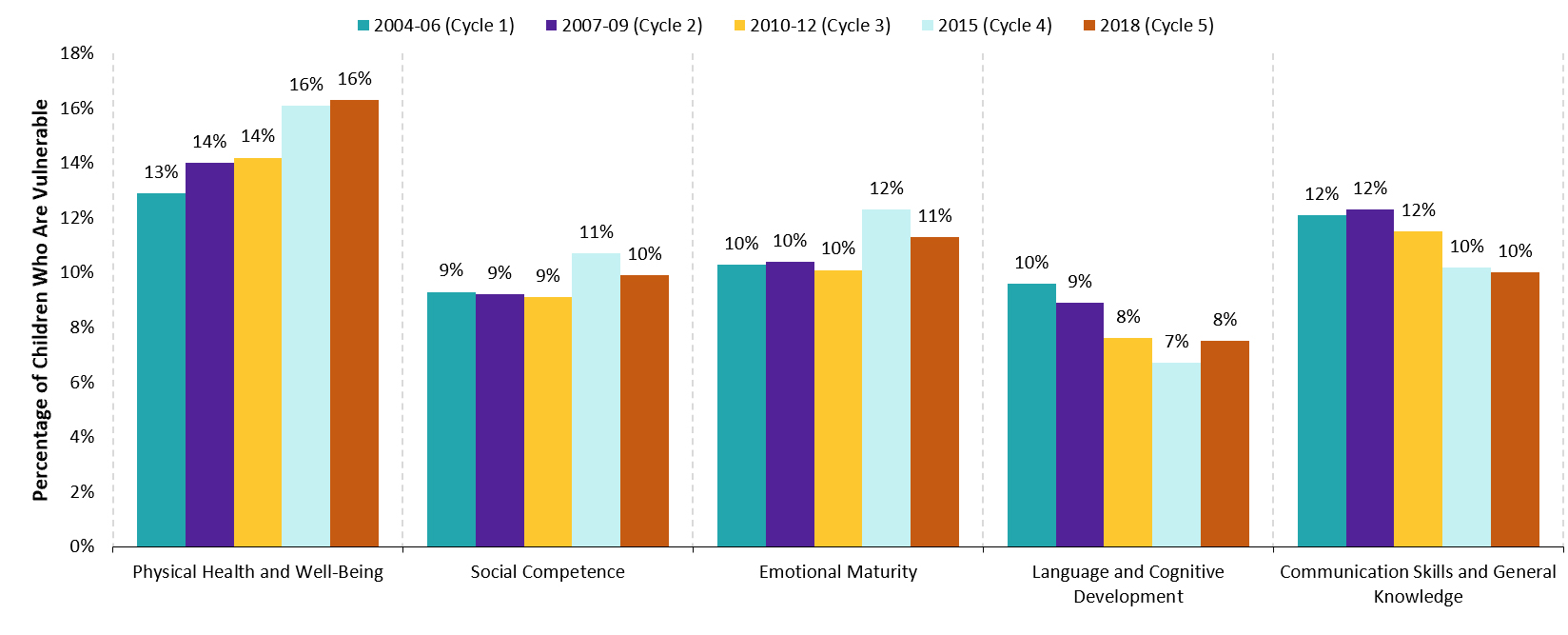
| Cycle | 2004-06 (Cycle 1) | 2007-09 (Cycle 2) | 2010-12 (Cycle 3) | 2015 (Cycle 4) | 2018 (Cycle 5) |
|---|---|---|---|---|---|
| Physical health and well-being | 13% | 14% | 14% | 16% | 16% |
| Social competence | 9% | 9% | 9% | 11% | 10% |
| Emotional maturity | 10% | 10% | 10% | 12% | 11% |
| Language and cognitive development | 10% | 9% | 8% | 7% | 8% |
| Communication skills and general knowledge | 12% | 12% | 12% | 10% | 10% |
Data source: Offord Centre for Child Studies, McMaster University.
Figure 16: Percentage of children who are vulnerable in one or more EDI domains, 2004-18
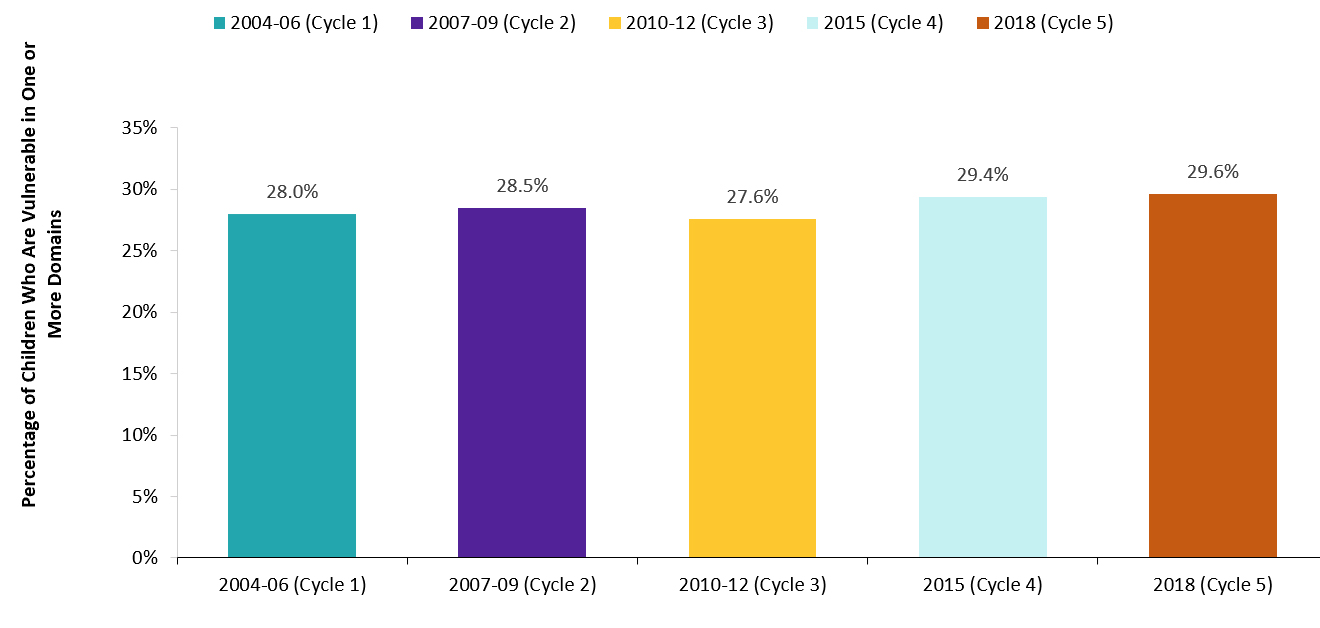
| Cycle | Percentage of children vulnerable in one or more domains |
|---|---|
| 2004-06 (Cycle 1) | 28.0% |
| 2007-09 (Cycle 2) | 28.5% |
| 2010-12 (Cycle 3) | 27.6% |
| 2015 (Cycle 4) | 29.4% |
| 2018 (Cycle 5) | 29.6% |
Data source: Offord Centre for Child Studies, McMaster University.
Part 3: Indicators under the Canada-Ontario Early Learning and Child Care Agreement
The federal government committed $400 million in their 2016 budget, and an additional $7 billion over 10 years in their 2017 budget, to establish a Multilateral Early Learning and Child Care Framework with provinces and territories. Under the framework, the federal government and these provinces and territories agreed to work together over time to achieve broad long-term goals for early learning and child care systems that are high quality, accessible, affordable, flexible, and inclusive. These provinces and territories also agreed to report annually on progress made in relation to the framework and on the impact of federal funding, while reflecting the priorities of each jurisdiction in early learning and child care.
On June 12, 2017, Ontario was the first province to sign an agreement under the framework, known as the three-year Canada-Ontario Early Learning and Child Care Agreement. Under the agreement, the federal government agreed to allocate $439 million to Ontario over three years (that is, 2017-18, 2018-19, and 2019-20).
- $100 million to support access for children and families to child care
- $40 million to support access to EarlyON Child and Family Centres
- $6 million to support innovative approaches that provide access to high quality training and professional learning opportunities for the early years and child care workforce
In July 2020, the federal and provincial governments agreed on a one-year extension of the Canada-Ontario Early Learning and Child Care Agreement, which allocated nearly $147 million in 2020-21 for early learning and child care investments. In August 2021, the federal and provincial governments agreed on a four-year renewal of the Canada-Ontario Early Learning and Child Care Agreement. Under the renewal, Ontario will receive nearly $147 million in federal funding in 2021-22 to continue early learning and child care investments in the province, and the annual funding will gradually increase to $211 million in 2023-24.
This section highlights Ontario’s progress in working towards increasing quality, accessibility, affordability, flexibility, and inclusion in early learning and child care under the Canada-Ontario Early Learning and Child Care Agreement. For more about the indicators that are being used to measure Ontario’s progress, see Appendix: List of Indicators under the Canada-Ontario Early Learning and Child Care Agreement.
Expenditures and actions
Under the agreement, Ontario received $146.7 million in federal funding in the 2020-21 fiscal year and $8.5 million was carried forwarded from the 2019-20 fiscal year. Ontario’s actual expenditures in the 2020-21 fiscal year were $155 million.
The 2020-21 funding supported the following three action areas:
- increasing access to affordable, high quality licensed child care
- increasing access to EarlyON Child and Family Centres
- innovative approaches to providing access to high quality training and professional learning opportunities for the early years and child care workforce
Table 5: Canada-Ontario early learning and child care agreement expenditures and actions for 2020-21
| Areas | Federal allocations | Actions | Actual expenditures |
|---|---|---|---|
| Licensed child care | Ontario allocated $100 million of the federal funding for increased subsidies and access to licensed child care in Ontario. | The federal funding was provided to service system managers through provincial-municipal service agreements. In December 2020, service system managers received consolidated 2021 service agreement and funding guidelines for licensed child care and EarlyON Child and Family Centres, including funding under the Canada-Ontario Early Learning and Child Care Agreement. | $111.5 million |
| EarlyON Child and Family Centres | Ontario allocated $40.3 million of the federal funding to support EarlyON Child and Family Programs across the province. | The federal funding was provided to service system managers to support 1,083 EarlyON Child and Family Centre locations across Ontario. | $40.3 million |
| Professional development | Ontario allocated $2 million of the federal funding to increase the number of students supported through the Early Childhood Educators Qualifications Upgrade Program. | The federal funding was provided through grants that were made available for 2020-21 to support individuals working in eligible early years and child care settings to obtain an early childhood education diploma and/or leadership certification. | $2.0 million |
| Professional development | Ontario allocated $1.5 million of the federal funding to support professional learning for the early years and child care workforce. | This funding supports culturally relevant professional learning strategies for Francophone and First Nation, Metis, Inuit and Indigenous staff. | $1.5 million |
Data source: Ontario Ministry of Education
Licensed child care indicators
The indicators reported in this section are reflective of the areas of investment under the agreement for increasing quality, accessibility, affordability, flexibility, and inclusion in licensed child care (see Appendix: List of Indicators under the Canada-Ontario Early Learning and Child Care Agreement).
Quality
Staff qualifications
Ontario Regulation 137/15 under the Child Care and Early Years Act, 2014 sets out the minimum requirements for staff qualifications in licensed child care centres and home child care agencies, including requirements for the ratio of employees to children, the maximum number of children in a group, and the proportions of employees that must be qualified employees in licensed child care centres, which varies for different age groups (see Table 6). The minimum requirements are as follows:
A supervisor shall be a person who:
- is a member in good standing of the College of Early Childhood Educators, has at least two years of experience providing licensed child care and is approved by a ministry director
- in the opinion of a director, is capable of planning and directing the program of a child care centre, being in charge of children and overseeing staff
A qualified employee for any licensed age group shall be a person who is:
- an employee who is a member in good standing of the College of Early Childhood Educators
- an employee who is otherwise approved by a director
With respect to a licensed junior school age group or a licensed primary/junior school age group that includes only children who are junior school age, the following are also qualified employees:
- an employee who has a diploma or degree in child and youth care
- an employee who has a diploma or degree in recreation and leisure services
- an employee who is a member in good standing with the Ontario College of Teachers
A home child care visitor is an employee of a home child care agency who monitors and provides support at licensed home child care locations. A home child care visitor shall be a person who:
- is a member in good standing of the College of Early Childhood Educators, has at least two years of experience working with children under 13 years old, and is approved by a director
- is, in the opinion of a director, capable of providing support and supervision at a home child care premises
Table 6: Staff/child ratios, group sizes and proportion of employees that must be qualified employees for different age categories in licensed child centre–based care
| Age categories | Age range | Ratio of employees to children | Maximum number of children in group | Proportion of employees that must be qualified employees |
|---|---|---|---|---|
| Infant | Younger than 18 months | 3 to 10 | 10 | 1/3 |
| Toddler | 18 months or older but younger than 30 months | 1 to 5 | 15 | 1/3 |
| Preschool | 30 months or older but younger than 6 years | 1 to 8 | 24 | 2/3 |
| Kindergarten | 44 months or older but younger than 7 years | 1 to 13 | 26 | 1/2 |
| Primary/junior school age | 68 months or older but younger than 13 years | 1 to 15 | 30 | 1/2 |
| Junior school age | 9 years or older but younger than 13 years | 1 to 20 | 20 | 1/1 |
Data source: Ontario Ministry of Education
For further information about child care rules in Ontario see Child Care Rules in Ontario.
The ministry monitors and enforces staff qualification requirements in all licensed child care centres and home child care agencies. Centres and agencies meet the requirements by employing supervisors, staff and home child care visitors who are RECEs, or through director approvals as described above. It is estimated that:
- 80% of licensed child care centres employed RECEs for supervisor positions
- 96% of licensed home child care agencies employed RECEs for all home child care visitor positions
In 2021, the most recent year for which there is data available, there were 28,412 full-time program staff employed by licensed child care centres of which 17,470 (61%) were RECEs.
Pedagogical framework
How does learning happen: Ontario’s pedagogy for the early years, 2014 is a professional learning resource for those working in child care and child and family programs. It supports pedagogy and program development in early years settings that is shaped by views about children, educators, and families, and the relationships among them. Additional regulations under the Child Care and Early Years Act, 2014 are also in place to help child care licensees embed How does learning happen into practice.
As of March 31, 2021, all licensed child care centres and home child care agencies had achieved compliance with the requirements regarding the development and implementation of a program statement that is consistent with How does learning happen either before their licence was first issued or before it was renewed. The ministry continues to support the implementation of the How does learning happen pedagogy in licensed child care programs in the province.
In 2020, the ministry released Building on how does learning happen: pedagogical approaches to re-opening early years and child care programs in Ontario to support providers and staff in engaging with children and families while adhering to health and safety measures.
Access
As of March 31, 2021, there were 464,538 licensed child care spaces in centres across the province, with 1,736 spaces added to the system over the previous year (see Table 7). It is estimated that there are enough spaces in licensed child care centres for 24% of children in the province.
Table 7: Ontario child population, licensed spaces and percentage of children with access to licensed child care, 2016-17 to 2020-21
| 2016-17 | 2017-18 | 2018-19 | 2019-20 | 2020-21 | |
|---|---|---|---|---|---|
| Child population aged 0-12 | 1,939,255 | 1,950,021 | 1,958,652 | 1,962,683 | 1,962,250 |
| Spaces in licensed child care centres | 406,395 | 427,032 | 446,596 | 462,802 | 464,538 |
| Percentage of children aged 0-12 for whom there are licensed child care spaces | 21.0% | 21.9% | 22.8% | 23.6% | 23.7% |
Data source: Child population data from Spring 2021 population projections, Ontario Ministry of Finance, and space data from Child Care Licensing System (CCLS), Ontario Ministry of Education.
Affordability
The funding under the Canada-Ontario Early Learning and Child Care Agreement supports new full and/or partial fee subsidies and increased access through the following priorities:
- supporting children aged 0–6 years through additional fee subsidies, increased access, broadly reducing licensed child care fees and by increasing affordability and/or not-for-profit community-based capital projects (excluding capital projects for child care programs that run during school hours for kindergarten and school age children)
- supporting children aged 0–12 years through additional fee subsides, increased access and/or broadly reducing licensed child care fees and by increasing affordability
In 2021, the most recent year for which there is data available, approximately 30% of children in licensed child care centres received a subsidy (see Figure 17), as did 54% of children in licensed home child care (see Figure 18).
Figure 17: Percentage of children in licensed child care centres receiving a full or partial subsidy by age, 2021
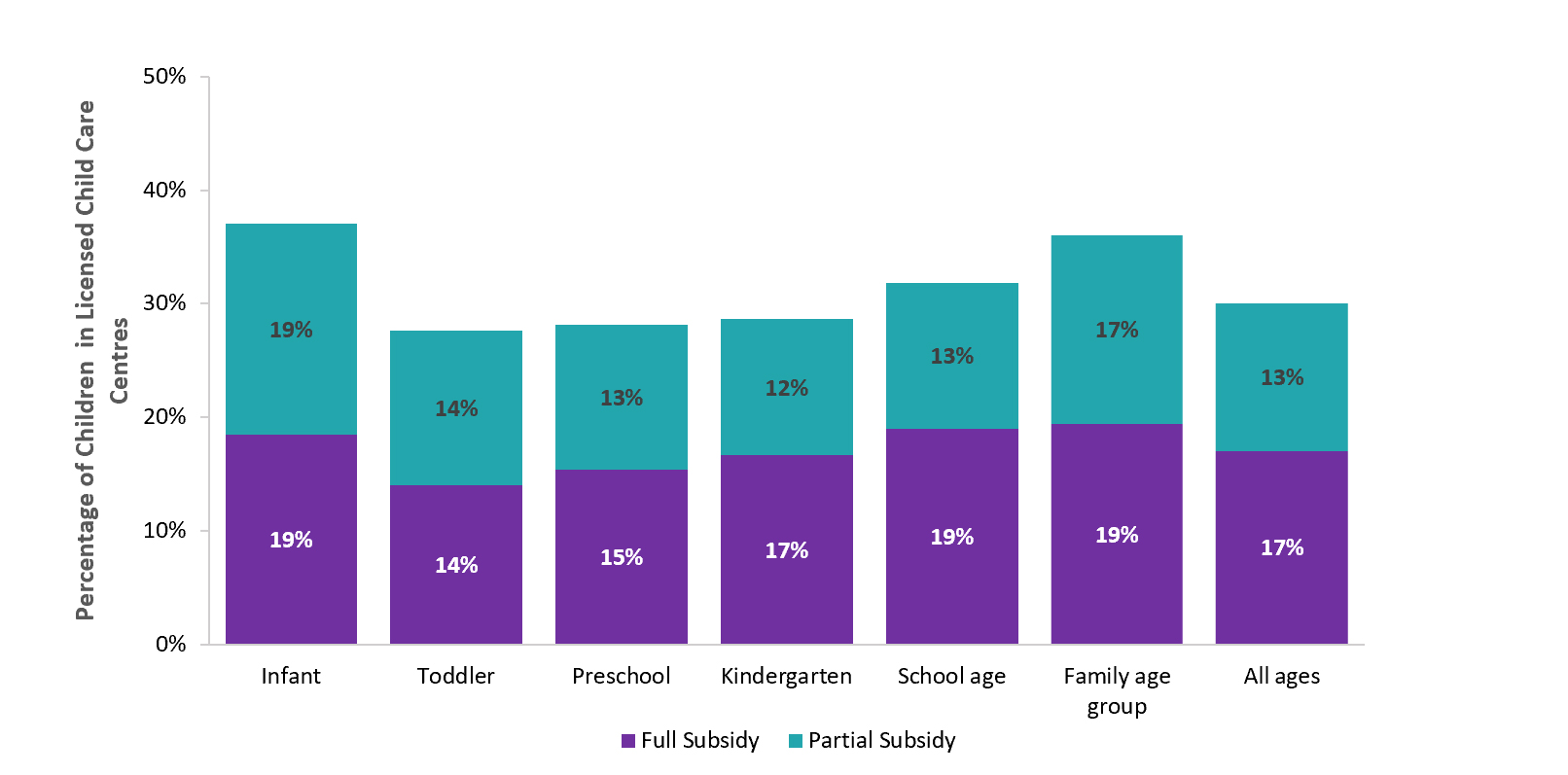
| Subsidy type | Full subsidy | Partial subsidy |
|---|---|---|
| Infant | 19% | 19% |
| Toddler | 14% | 14% |
| Preschool | 15% | 13% |
| Kindergarten | 17% | 12% |
| School age | 19% | 13% |
| Family age group | 19% | 17% |
| All ages | 17% | 13% |
Data source: 2021 Licensed Child Care Operations Survey, Ontario Ministry of Education (as of March 31, 2021).
Figure 18: Percentage of children in licensed home child care receiving a full or partial subsidy by age, 2021
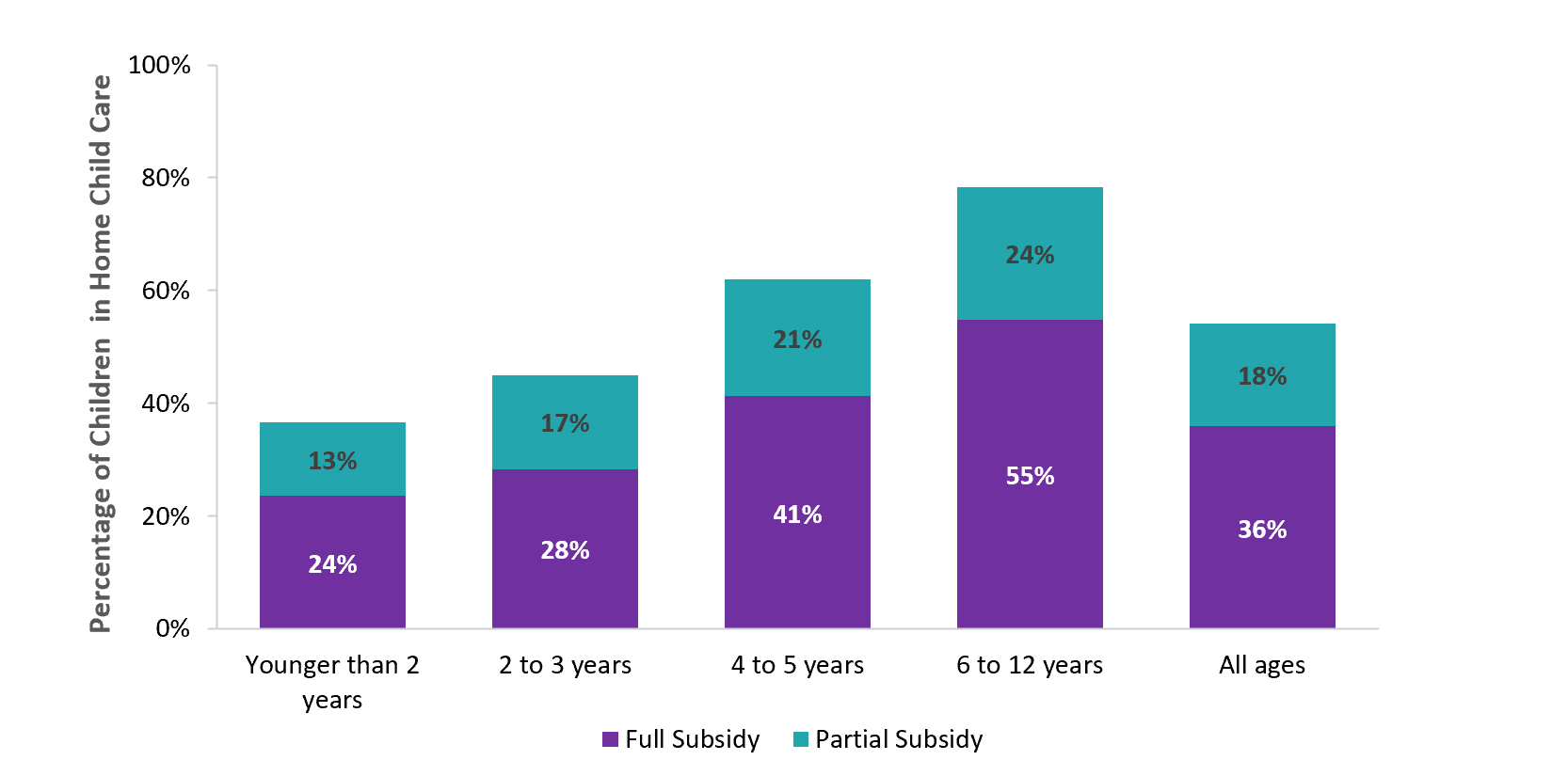
| Subsidy type | Full subsidy | Partial subsidy |
|---|---|---|
| Younger than 2 years | 24% | 13% |
| 2 to 3 years | 28% | 17% |
| 4 to 5 years | 41% | 21% |
| 6 to 12 years | 55% | 24% |
| All ages | 36% | 18% |
Data source: 2021 Licensed Child Care Operations Survey, Ontario Ministry of Education (as of March 31, 2021).
In 2019, the most recent year for which there is data available, 150,474 children in Ontario received fee subsidies.
It is estimated that 72% of children who receive fee subsidies live in families with incomes of $40,000 and below (see Table 8).
Table 8: Percentage of children receiving fee subsidies by family income, 2019footnote 24
| Family income | Percentage |
|---|---|
| $20,000 and below | 38% |
| $20,001 - $40,000 | 34% |
| $40,001 - $60,000 | 18% |
| $60,001 - $80,000 | 6% |
| $80,001 - $100,000 | 2% |
| $100,000 and above | 1% |
| Total | 100% |
Data source: Education Finance Information System (estimated percentages), Ontario Ministry of Education.
Flexibility and inclusion
Non-standard hours
Flexibility in child care service delivery is important for meeting the needs of parents and caregivers who work non-standard schedules. In Ontario, a small proportion of licensed child care centres and home child care providers offer care during non-standard hours.
- 9% of child care centres reported the availability of weekend care and less than 1% reported the availability of care during the evening or overnight
- 10% of home child care providers reported the availability of weekend care, 11% reported the availability of evening care and 6% reported the availability of overnight care
Special needs resourcing
The province provides Special Needs Resourcing funding to service system managers and First Nations to support the inclusion of children with special needs in licensed child care settings, including home child care, camps, and authorized recreation programs, at no additional cost to parents/guardians. Under Ontario Regulation 138/15, a “child with special needs” means a child whose cognitive, physical, social, emotional, or communicative needs, or whose needs relating to overall development, are of such a nature that additional supports are required for the child. A total of 37,508 children were funded through Special Needs Resourcing between January 1 and December 31, 2019, the most recent year for which there is data available.
Indigenous-led child care centres
A total of 22 licensed child care centres reported that they were Indigenous-led organizations operating in urban and rural communities.
French-language and bilingual child care
As of March 31, 2021, a total of 307 centres offered French-language programs and 97 centres offered bilingual programs.
Children in licensed child care by income
The ministry does not collect income data from families that enroll their children in licensed child care. This indicator is estimated using the number of licensed child care spaces in the province and data on the distribution of families across income levels from Statistics Canada.
As of March 31, 2021, there were 464,538 licensed child care spaces for children aged 0–12 years in Ontario. Approximately 21.6% of families with children in the province earned a family income below $40,000, 39.7% earned between $40,000 and $100,000, and 38.7% earned above $100,000.
It is estimated, based on the income distribution, that:
- more than 100,000 spaces are used by children from families with income below $40,000
- about 185,000 spaces are used by children from families with income between $40,000 and $100,000
- about 180,000 are used by children from families with income above $100,000
EarlyON Child and Family Centres indicators
The indicators reported in this section are reflective of the areas of investment under the Canada-Ontario Early Learning and Child Care Agreement for increasing quality, accessibility, affordability, flexibility and inclusion in child and family centres (see Appendix: List of Indicators under the Canada-Ontario Early Learning and Child Care Agreement).
Quality
Staff qualifications
Experiences in EarlyON Child and Family Centres are designed to foster positive outcomes and support nurturing relationships for children and their parents and caregivers based on the latest evidence and research. Registered Early Childhood Educators (RECEs) play a key role in delivering high quality early years programs because they have specialized knowledge and expertise in child development and in play- and inquiry-based learning.
Every EarlyON Child and Family Centre should employ at least one RECE, who oversees all mandatory core services related to supporting early learning and development. If an EarlyON Child and Family Centre is unable to recruit at least one RECE to deliver these core services, the service system manager may grant an exemption from the requirement but must report the number of exemptions to the ministry.
EarlyON Child and Family Centres must ensure that they have at least one RECE on staff by January 1, 2023. However, EarlyON staff who are not RECEs but have more than 10 years of experience in relevant programs can be employed to meet this staffing requirement through a new grandparenting provision.
Pedagogical framework
EarlyON Child and Family Centres are expected to provide programs that reflect the view of children, parents and caregivers, and educators as competent, capable, curious, and rich in potential and experience. Guided by How does learning happen: Ontario’s pedagogy for the early years, EarlyON Child and Family Centres offer an environment that engages parents and caregivers as co-learners and leaders in influencing positive child, family, and community experiences and outcomes.
Access, affordability, flexibility, and inclusion
As of March 2021, there were 1,083 EarlyON Child and Family Centre locations across Ontario, of which 419 were main EarlyON Child and Family Centre locations and 664 were mobile/satellite EarlyON Child and Family Centre locations. In addition, there were approximately 198 EarlyON Child and Family Centres offering virtual services supports to meet the needs of families across the province.
Of the total number of locations, 381 locations offered non-standard hours, 132 offered French-language programming and 176 offered Indigenous programming.
As of Summer 2020, 81 new EarlyON Child and Family rooms in 45 locations were either complete or in the process of being established. These capital projects were initially approved in 2017-18 through the Community-Based Early Years and Child Care Capital Program, with the EarlyON Child and Family Centre portion of the capital projects funded under the Canada-Ontario Early Learning and Child Care Agreement.
The ministry is also monitoring EarlyON expansion supported through operating funding under the agreement. In 2018-19, the ministry allocated approximately $8.6 million to service system managers for community-based EarlyON Child and Family Centre funding needs, including:
- capital costs associated with previously approved projects
- first-time equipping
- minor capital renovations
- supplies to support the delivery and daily operation of programs
- maintenance
In 2019, the most recent year for which there is data available, 384,851 children were served by child and family programs at EarlyON centres,
Table 9: Number of children served and visits to child and family programs, 2018 to 2019
| Item | 2018 | 2019 | Per cent change |
|---|---|---|---|
| Number of children served | 401,116 | 384,851 | -4.1% |
| Number of visits by children | 2,733,002 | 2,590,151 | -5.2% |
| Number of visits by parents or caregivers | 2,083,118 | 2,105,538 | 1.1% |
Data source: Ontario Ministry of Education.
Professional learning indicators
The indicators reported in this section are reflective of the area of investment under the agreement for innovative approaches to providing access to high quality training and professional learning opportunities for the early years and child care workforce (see Appendix: List of Indicators under the Canada-Ontario Early Learning and Child Care Agreement).
Early childhood educators qualifications upgrade program
This program enables individuals working in eligible child care and early years settings to apply for grants to support them in obtaining an early childhood education diploma and becoming eligible to apply for membership with the College of Early Childhood Educators. The program also provides opportunities for leadership development, targeted to those who are working in supervisory roles or who aspire to do so, and who are already RECEs. In addition, the program prioritizes funding for Francophone and First Nations, Métis and Inuit applicants, as well as individuals working under director approvals or Letters of Permission.
Financial support is available to eligible applicants in the form of education grants, travel grants, and training allowances.
In 2020-21, the ministry allocated $3.5 million in provincial funding and $2 million in federal funding for the Early Childhood Educators Qualifications Upgrade Program. The ministry continues to work towards expanding access to the program to increase the number of RECEs in child care and early years programs. For example, part-time students (in addition to full-time students) are now eligible for direct sponsorship, where the grant program pays the school directly for the cost of tuition fees rather than requiring the students to pay up front and be reimbursed. In 2020-21, a total of 2,036 applications were approved under the Early Childhood Educators Qualifications Upgrade Program, an increase of 30% from 2018-19.
Professional learning strategy for Francophone and Indigenous professionals
Given that the professional learning needs are often heightened in Francophone and Indigenous communities and fewer supports are available, focused professional learning opportunities have been provided to better meet needs through more targeted, differentiated cultural and regional approaches.
In 2020-2021, the ministry allocated $1.5 million in federal funding to three organizations to support three professional learning for Francophone and Indigenous professionals in the early years and child care sector. This funding was allocated to the following organizations:
- Association francophone à l’éducation des services à l’enfance de l’Ontario (AFÉSEO) for early years and child care professionals working in francophone settings
- FIREFLY for early years and child care professionals in First Nations communities on-reserve
- Ontario Aboriginal Head Start Association (OAHSA) for early years and child care professionals working with First Nation, Metis, Inuit or Indigenous off-reserve settings
Funds provided to these organizations aim to enhance culturally relevant programming and the delivery of high-quality child care and early years programs, in alignment with How does learning happen. The organizations also create linkages to and/or develop professional learning resources that are responsive to the needs of the sector.
Appendix: List of indicators under the Agreement
| Principles | Indicators related to planned investment | Indicators as reported by Ontario | Reference to the data in the report |
|---|---|---|---|
| High quality child care | |||
| High quality | Number and percentage of providers with Early Childhood Education (ECE) certification | Number and percentage of program staff who are Registered Early Childhood Educators (RECEs) Percentage of licensed child care centres employing only RECEs for the positions requiring qualified employees | See "Staff Qualifications" under "Licensed Child Care Indicators" |
| High quality | Number and percentage of programs adopting Ontario’spedagogy for the early years, How does learning happen | Number of affirmations confirming programming alignment with How does learning happen | See "Pedagogical Framework" under "Licensed Child Care Indicators" |
| Accessible affordable and flexible | Number and percentage of children who have access to licensed child care | Percentage of children aged 0-12 years for whom there are licensed child care spaces | See "Access" under "Licensed Child Care Indicators" |
| Accessible affordable and flexible | Number and percentage of children receiving subsidies | Number and percentage of children receiving child care fee subsidies | See "Affordability" under "Licensed Child Care Indicators" |
| Accessible affordable and flexible | Number and percentage of licensed child care programs that offer flexible hours | Number and percentage of programs providing care during non-standard hours | See "Flexibility and Inclusion" under "Licensed Child Care Indicators" |
| Accessible affordable and flexible | Number of additional licensed child care spaces created | Number of additional licensed child care spaces created in licensed centres | See "Access" under "Licensed Child Care Indicators" |
| Accessible affordable and flexible | Number of children receiving subsidy by family income | Number and percentage of children receiving child care fee subsidies by family income | See "Affordability" under "Licensed Child Care Indicators" |
| Inclusive | Number of child care programs designed to serve French linguistic minority communities and Indigenous People off-reserve | Number of French-language licensed child care centres | See "French-language and Bilingual Child Care" under "Licensed Child Care Indicators" |
| Inclusive | Number of child care programs designed to serve French linguistic minority communities and Indigenous People off-reserve | Number of Indigenous-led centres in urban and rural communities | See "Indigenous-led Child Care Centres" under "Licensed Child Care Indicators" |
| Inclusive | Number of children with additional support needs participating in child care programs | Number of children funded through Special Needs Resourcing | See "Special Needs Resourcing" under "Licensed Child Care Indicators" |
| Inclusive | Number and proportion of children from low-income and middle class families participating in early learning and child care programs | Number and percentage of children for whom a licensed space is available by income | See "Children in Licensed Child Care by Income" under "Licensed Child Care Indicators" |
| High quality early learning | |||
| High quality | Number and percentage of providers with Early Childhood Education (ECE) certification | Qualification requirements for program staff working in child and family centres | See "Staff Qualifications" under "EarlyON Child and Family Centres Indicators" |
| High quality | Number and percentage of programs adopting Ontario’s pedagogy for the early years, How does learning happen | Service guideline requires programming alignment with How does learning happen | See "Pedagogical Framework" under "EarlyON Child and Family Centres Indicators" |
| Accessible affordable and flexible | Number of new EarlyON Child and Family Centres (including full and part-time locations) | Number of EarlyON Child and Family programs offering full- and part-time hours | See "Access, Affordability, Flexibility and Inclusion" under "EarlyON Child and Family Centres Indicators" |
| Accessible affordable and flexible | Number of child and family visits to early learning programs | Number of child and family visits to EarlyON Child and Family Centres | See "Access, Affordability, Flexibility and Inclusion" under "EarlyON Child and Family Centres Indicators" |
| Accessible affordable and flexible | Number and percentage of children who have access to early learning programs | Number and percentage of children served by EarlyON Child and Family Centres | See "Access, Affordability, Flexibility and Inclusion" under "EarlyON Child and Family Centres Indicators" |
| Accessible affordable and flexible | Number and percentage of early learning programs that offer flexible hours | Number and percentage of EarlyON Child and Family programs that offer programming during non- standard hours | See "Access, Affordability, Flexibility and Inclusion" under "EarlyON Child and Family Centres Indicators" |
| Inclusive | Number of early learning programs designed to serve French linguistic minority communities and Indigenous People off-reserve | Number of child and family centres that offer culturally relevant programming for Indigenous children and families | See "Access, Affordability, Flexibility and Inclusion" under "EarlyON Child and Family Centres Indicators" |
| Inclusive | Number of early learning programs designed to serve French linguistic minority communities and Indigenous People off-reserve | Number of child and family centres that offer French-language programming for Francophone children and families | See "Access, Affordability, Flexibility and Inclusion" under "EarlyON Child and Family Centres Indicators" |
| Professional learning | |||
| Early Childhood Educators qualifications upgrade program | Number of individuals supported through the Early Childhood Educators Qualifications Upgrade Program per annum | Number of individuals supported through the Early Childhood Educators Qualifications Upgrade Program | See "Early Childhood Educators Qualifications Upgrade Program" under "Professional Learning Indicators" |
| Innovative service delivery | Innovative service delivery to support professional learning | Number of professional learning initiatives supported | See “Professional Learning Strategy for Francophone and Indigenous Professionals” |
##-###
ISSN ####-#### (Online)
The Ministry of Education acknowledges the Government of Canada's support in connection with the Multilateral Early Learning and Child Care Framework and the Canada-Ontario Early Learning and Child Care Agreement. Part 3 of this document outlines Ontario's progress towards meeting early learning and child care goals under the agreement.
Footnotes
- footnote[1] Back to paragraph The "family age group" designation allows children of different ages in the same family to be placed in the same group in a play activity room, as long as they are between the ages of 0-12 years. This designation is used by licensed child care centres and came into effect on September 1, 2017.
- footnote[2] Back to paragraph “Approved homes” refers to the maximum number of homes that an agency is permitted to contract with.
- footnote[3] Back to paragraph Data source: 2021 Licensed Child Care Operations Survey, Ontario Ministry of Education. All licensed child care centres and home child care agencies that were operating as of March 31, 2021, were asked to complete the 2021 survey, and more than 97% did so.
- footnote[4] Back to paragraph “Active homes” refers to the number of home child care providers that have a contract/agreement with an agency.
- footnote[5] Back to paragraph In years prior to 2013-14, the total number of spaces may not be equal to the sum of the spaces, due to the exclusion of alternate capacity from the totals up to that point. Alternate capacity refers to spaces that are licensed for different age groups to be used at different times.
- footnote[6] Back to paragraph “Auspice” refers to the ownership and operation of a service. In this report, licensed child care centres are categorized into two types of auspice: not-for-profit and for-profit.
- footnote[7] Back to paragraph Different sets of age categories were used to collect data for licensed child care centres and licensed home child care agencies. Age categories used for licensed child care centres are in accordance with the Child Care and Early Years Act, 2014. These age categories do not apply to licensed home child care.
- footnote[8] Back to paragraph Ontario Regulation 137/15 sets out rules under the Child Care and Early Years Act, 2014 governing staff in licensed child care centres. For each group of children in licensed child care centres, the licensee is required to employ at least one program staff member who is listed on the College of Early Childhood Educators’ Public Register as a member in good standing or who has been otherwise approved by a director. For more information, see “Staff Qualifications” under “Licensed Child Care Indicators”.
- footnote[9] Back to paragraph The percentages stated for March 1, 2020, June 30, 2020, August 31, 2020 and March 31, 2021 are based on data from the 2021 Licensed Child Care Survey. The percentages stated for December 31, 2020 are based on data from the Child Care Licensing System.
- footnote[10] Back to paragraph Data source: EarlyON web page on Ontario.ca, Ontario Ministry of Education.
- footnote[11] Back to paragraph 113,323 EDI questionnaires were analysed for Cycle 1; 110,916 for Cycle 2; 119,494 for Cycle 3; 125,858 for Cycle 4; and 123,912 for Cycle 5.
- footnote[12] Back to paragraph “Vulnerable” describes children who score below the 10th percentile of the Ontario EDI baseline population scores. This indicates that they are struggling in comparison to the baseline population.
- footnote[13] Back to paragraph Actual allocations may vary according to the latest population estimates.
- footnote[14] Back to paragraph Totals may not add up due to rounding.
- footnote[15] Back to paragraph Figure is subject to change upon the completion of the 2020-21 audit.
- footnote[16] Back to paragraph Final expenditures are subject to change pending the 2020-21 audit.
- footnote[17] Back to paragraph Includes carry-forward funding from 2019-20 to 2020-21.
- footnote[18] Back to paragraph Data source: Child Care Licensing System, Ontario Ministry of Education, as of March 31, 2021.
- footnote[19] Back to paragraph Data source: 2021 Licensed Child Care Operations Survey, Ontario Ministry of Education (as of March 31, 2021).
- footnote[20] Back to paragraph The estimation does not account for children cared for in homes contracted with licensed home child care agencies.
- footnote[21] Back to paragraph All the percentages of children aged 0-12 years for whom there are licensed child care spaces have been updated with the Spring 2021 population projection data.
- footnote[22] Back to paragraph Data source: Education Finance Information System, Ontario Ministry of Education. The total number includes federal, provincial, and municipal funding sources.
- footnote[23] Back to paragraph Data source: Education Finance Information System, Ontario Ministry of Education.
- footnote[24] Back to paragraph The percentage of children receiving subsidy by family income does not add up due to rounding.
- footnote[25] Back to paragraph Data source: 2021 Licensed Child Care Operations Survey, Ontario Ministry of Education (as of March 31, 2021).
- footnote[26] Back to paragraph Data source: Education Finance Information System, Ontario Ministry of Education. The total number includes federal, provincial, and municipal funding sources.
- footnote[27] Back to paragraph Data source: 2021 Licensed Child Care Operations Survey, Ontario Ministry of Education (as of March 31, 2021).
- footnote[28] Back to paragraph Data source: Statistics Canada, 2016 Census of Population, Statistics Canada Catalogue no. 98-400-X2016104.
- footnote[29] Back to paragraph Data source: Ontario Ministry of Education.
- footnote[30] Back to paragraph Percentage is an estimate based on the number of children served and the total population of children in the province aged 0-6 years.
- footnote[31] Back to paragraph Data source: Ontario Ministry of Education. Based on the most recent year of data available.
- footnote[32] Back to paragraph Data source: Ontario Ministry of Education. The 2020-21 total is based on an annual report submitted by the program administrator. The total number includes federal and provincial funding sources.
- footnote[33] Back to paragraph This column lists the indicators outlined in the Canada-Ontario Early Learning and Child Care Agreement.
- footnote[34] Back to paragraph “Early learning” under the Canada-Ontario Early Learning and Child Care Agreement refers to EarlyON Child and Family Centres within the context of Ontario.